Last-Minute NYC Holiday Gift Guide 🎁
We’ve created a holiday gift guide with presents for the intrepid New Yorker that should arrive just in time—


While the summer may be starting to wind down, public art across New York City is continuing to flourish. Whether tucked away in the heart of Prospect Park or out in the open at Rockefeller Center, there are many new art installations to choose from. This September, be sure to check out highlights such as Sean Desiree’s outdoor orchestra Beam Ensemble, CowParade’s beautiful sculptures scattered in “pastures” across the five boroughs, and the brand new photography installation Faces of Harlem. In addition, don’t forget to keep reading to learn more about art installations still up from previous months.
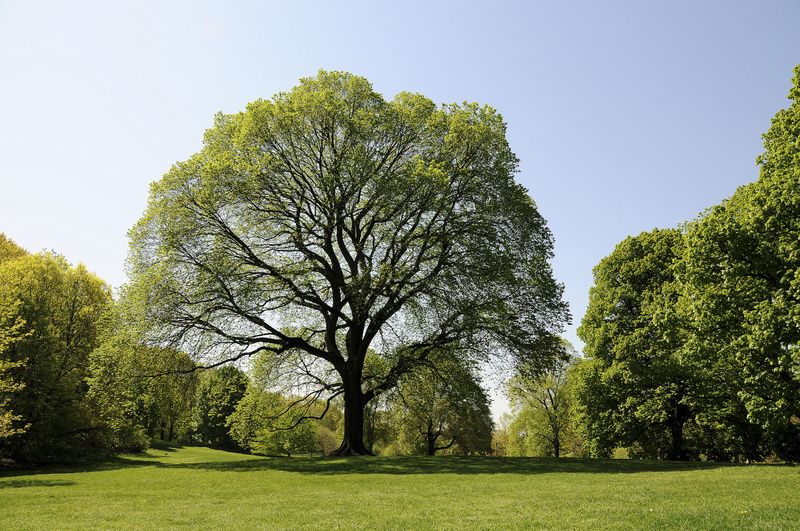
From September 18 to October 10, 2021, Kamala Sankaram — the second recipient of Creative Time’s Emerging Artist Open Call — will present The Last Stand, a sound installation featuring an experimental opera composed specifically for and about trees. The Last Stand aims to call attention to the current climate crisis and environmental degradation with an emphasis on humanity’s responsibility to the natural world. In her work, Sankaram masterfully translates scientific literature, tree communication and historic environmental sounds into subsonic vibrations. Sankaram’s one-of-a-kind narrative is uniquely accessed by the trees themselves through the ground and by human listeners, even being brought to deaf and hard-of-hearing visitors through vibrational benches. Its inspiration comes from Dr. Suzanne Simard‘s research on trees’ capabilities of communicating and maintaining interspecies relationships through underground fungal networks.
Located in the heart of Prospect Park, The Last Stand chronicles the life span of a 300-year-old Northern Red Oak from 1750 to 2050. The story is told through a series of field recordings from woodlands including Black Rock Forest, a 4,000-acre diverse ecosystem in upstate New York. Over the course of 10 hours, The Last Stand highlights the tree’s life from its birth as an acorn to its final moments, when its energy disperses into the universe. Included in the recording are animal and tree canopy noises and sounds that mimic moments of a life-altering tragedy, such as invasions from non-native insects and human-induced natural disasters. The Last Stand hints at the catastrophic impact that climate change will have on our planet. As Creative Time Associate Curator Diya Vij commented: “Kamala Sankaram breaks open the possibilities of opera in her first public artwork. Composed entirely of field recordings and archival sounds of the forest, this experimental soundscape takes the life of a tree as its starting point, de-prioritizing the human experience and reorienting us to the expanse and necessity of multi-species kinship.”
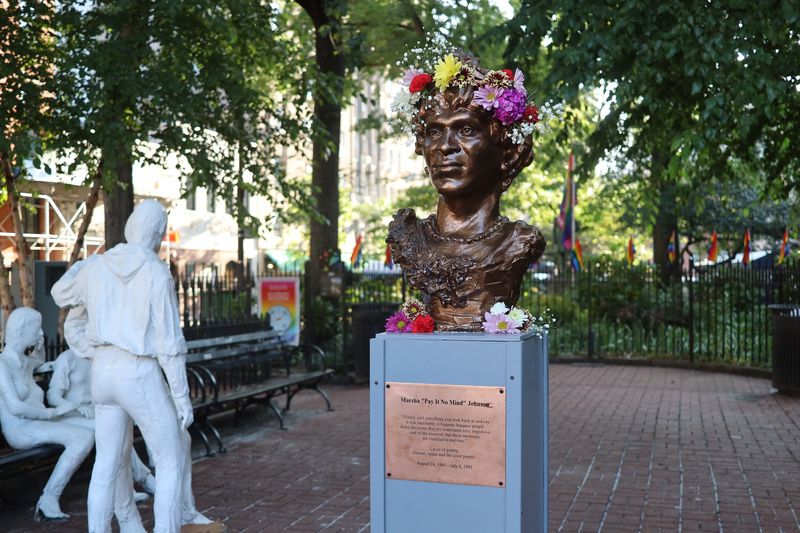
In Christopher Park, a bust of Black transgender LGBTQ activist Martha P. Johnson was recently erected on August 24th, which would have been her 76th birthday. Today, Johnson is known for her crucial role in the 1969 Stonewall Riots and for co-creating with fellow transgender activist Sylvia Rivera the Street Transvestite Action Revolutionaries (STAR), which sought to provide housing for LGBTQ youth. Later, Johnson served as a staunch activist for survivors during the AIDS crisis before her death in 1992. The city announced in 2019 that it planned to create memorials near the Stonewall Inn for Johnson and Rivera, but these plans never came to fruition. However, rather than continuing to wait for the city to make due on its promise, writer and activist Eli Erlick, sculptor Jesse Pallotta and a number of fellow organizers created a bronze bust of Johnson and installed it inside the park. Additional help in creating the bust was provided by Tourmaline, an artist and filmmaker whose hundreds of archived photos of Johnson gave Pallotta a deeper understanding of her features from every angle.
The bust features Johnson softly smiling with a colorful flower tiara adorning her head. Below the bust is a plaque that honors Johnson’s love of poetry, flowers, space and the color purple. It includes a quote which reads, “History isn’t something you look back at and say it was inevitable. It happens because people make decisions that are sometimes very impulsive and of the moment, but those moments are cumulative realities.” Currently, it is unknown as to how long the bust will remain in the park, but it was specifically designed with the intention of only being up temporarily. It is Erlich and Pallota’s hope that the bust will inspire the city to follow through with creating monuments to Johnson and Rivera and involve Black trans women leaders in New York City in the design process.
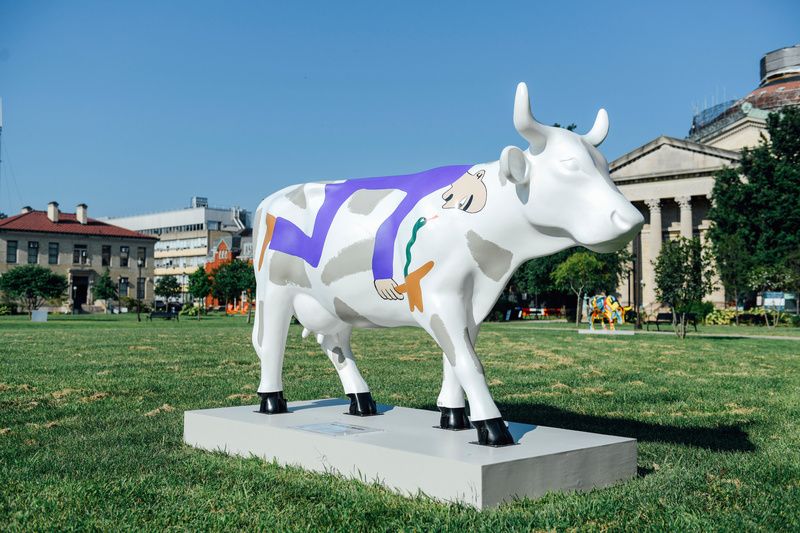
From August 18 through September 30, 2021, God’s Love We Deliver will be bringing back CowParade to New York City. Known as one of the largest and most successful public art events in the world, CowParade has been staged in over 80 venues since 1999. The event features a series of colorfully designed cow sculptures displayed for public enjoyment. Over the years, around 5,000 cows have been created and were viewed by more than 250 million people. Following the end of every event, the cows are put up for auction, with profits given away to worldwide charitable organizations. Over the past 22 years, CowParade has raised more than $30 million.
This year in New York City, the cow sculptures will be placed in eight pastures across the five boroughs. These locations include Industry City, Hudson Yards, the New York Hall of Science, Bronx Community College, the National Lighthouse Museum, Rockaway Beach, Macy’s at 34th Street and Bloomingdale’s at 59th Street. The cows will be sold by Heritage Auctions to benefit God’s Love.
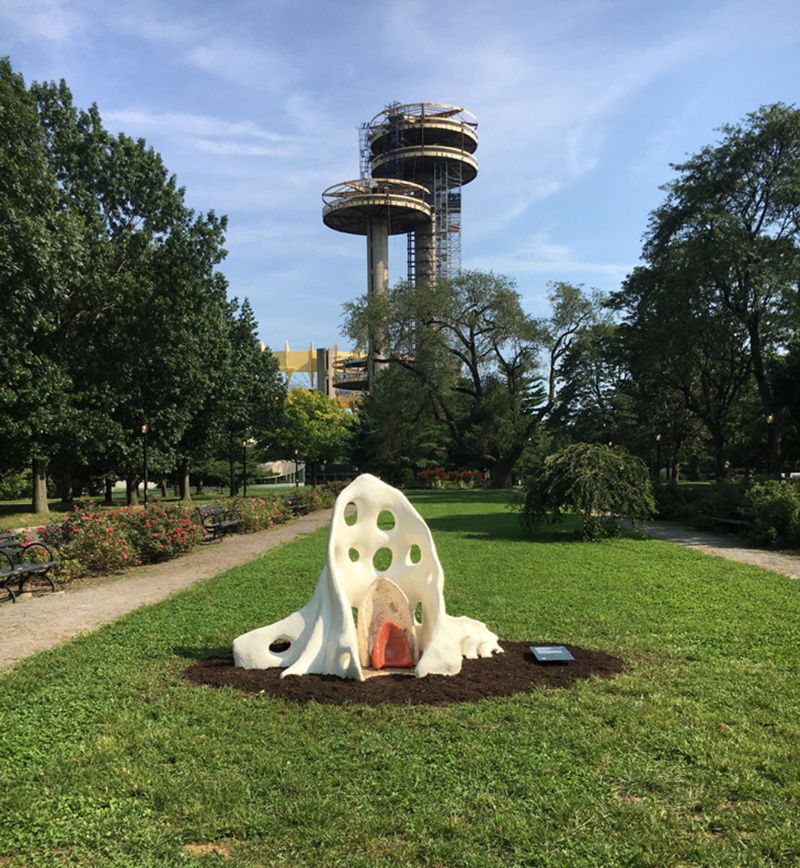
Through August 10, 2022, Endangered Fossils by Judith Modrak will be on display at Flushing Meadows-Corona Park in Queens. Endangered Fossils features a series of sculptures meant to represent an imagined archeological excavation of New York State’s fossil record. Inspiration for the sculptures was drawn from trilobites, brachiopods and crinoids present from the Devonian period 400 million years ago — which today can be recognized for their similarities to modern crabs, clams and starfish. Each sculpture prompts its audience to consider the origins of our ecosystem.
As Modrak writes in her artist statement: “The larger concept was very much about the fossil record in light of disastrous climate change which is causing many species to tragically become extinct, fossils are even “endangered” as certain species may not leave a trace that they ever existed. Endangered Fossils is a homage to our beloved Mother Earth in a critical time requiring immediate attention.”
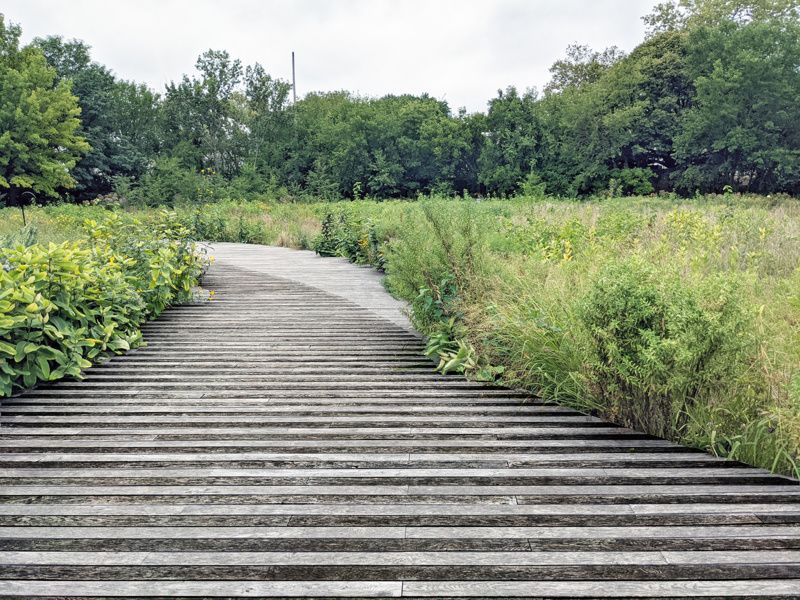
This fall, Layers will be presented in the Naval Cemetery Landscape, located on the southeast corner of the Brooklyn Navy Yard. Created by Aaron Asis (Untapped New York’s Artist-in-Residence), the art installation will be uniquely split into two distinct parts — with both asking viewers to contemplate the impact of human intervention in natural spaces during the past, present, and future. Specifically, Layers centers on the multifaceted history of the Naval Cemetery Landscape and Brooklyn Navy Yard. From 1831 to 1910, before the Naval Cemetery Landscape existed, the Brooklyn Naval Hospital Cemetery was an active burial site. However, in 1926, the Navy relocated individuals buried in the cemetery to Cypress Hills National Cemetery. Years later during the 1990s, archeological investigations discovered that there are potentially hundreds of unaccounted burials still located underneath the cemetery. In 2016, the Brooklyn Greenway Initiative would open the Naval Cemetery Landscape on the site of the former cemetery, meaning for it to become a place for retreat and remembrance.
As part of Layers, on the entry wall to the Naval Cemetery Landscape, there will be a large-scale paper mural that displays the pre-developmental landscape surrounding the Brooklyn Navy Yards and the Naval Cemetery Landscape. Inside the cemetery, there will be a beautiful and immersive display of hundreds of stripes along the boardwalk, each meant to represent pre-development patterns in the landscape as a demonstration of how humans have impacted the land since their arrival. Along the chalked stripes will be footprints highlighting and honoring the lives historically laid to rest in the cemetery. Layers’ will be completed on September 16th and will run through October 10, 2021. You can see this installation in its first few days by joining a fundraiser garden party with the Brooklyn Greenway in the Naval Cemetery Landscape on September 18th.
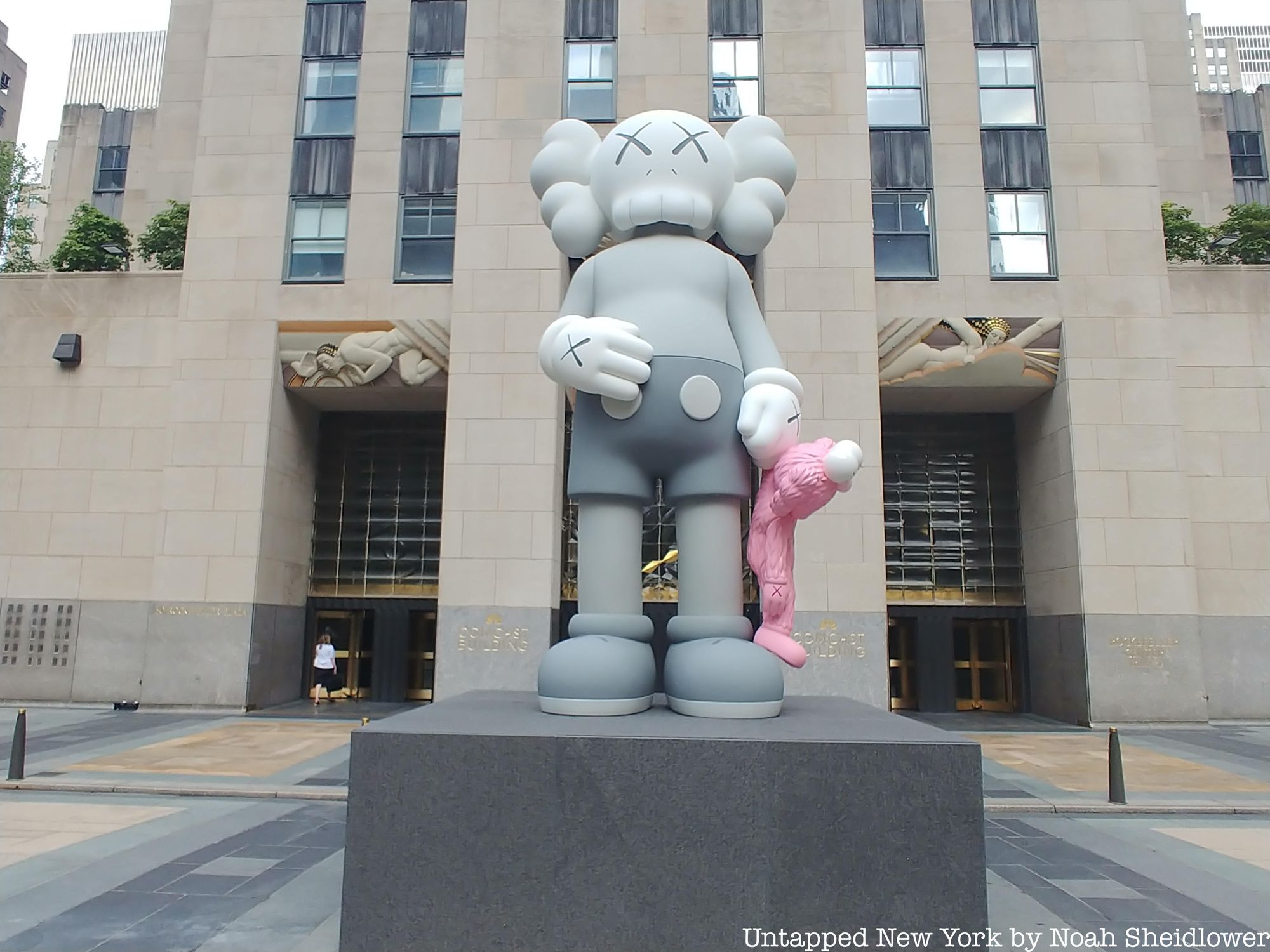
Standing outside Rockefeller Center is SHARE, a brand new 18-foot-tall bronze sculpture on view through October 8, 2021. Created by renowned street artist KAWS, SHARE is made of two distinct pieces entitled COMPANION and BFF. The first part of the sculpture, COMPANION, has a Mickey Mouse-inspired appearance, bearing the character’s signature pants and shoes. However, rather than simply evoking a sense of happiness and childlike wonder that is commonly associated with the Disney star, COMPANION’s design has an underlying menacing theme. The “x” over the sculpture’s eyes — which are commonly used to connote death — evoke sentiments of fear and isolation. This is further amplified by the sculpture’s gray color and lack of smile. In contrast, BFF — a pink furry Elmo knockoff held between COMPANION’s hands — reminds viewers of the comfort they search for in their daily lives. SHARE is presented in tandem with KAWS’s other current exhibit, KAWS: What Party, located at the Brooklyn Museum until September 5, 2021.
As EB Kelly, Tishman Speyer’s managing director overseeing Rockefeller Center, stated: “KAWS has created a universal language for anyone who interacts with his instantly recognizable figures. KAWS’s work subverts expectations while feeling familiar and stylized, and having SHARE close our summer season of art at Rockefeller Center perfectly encapsulates our own commitment to contrast New York’s different cultures, styles, and energy.”
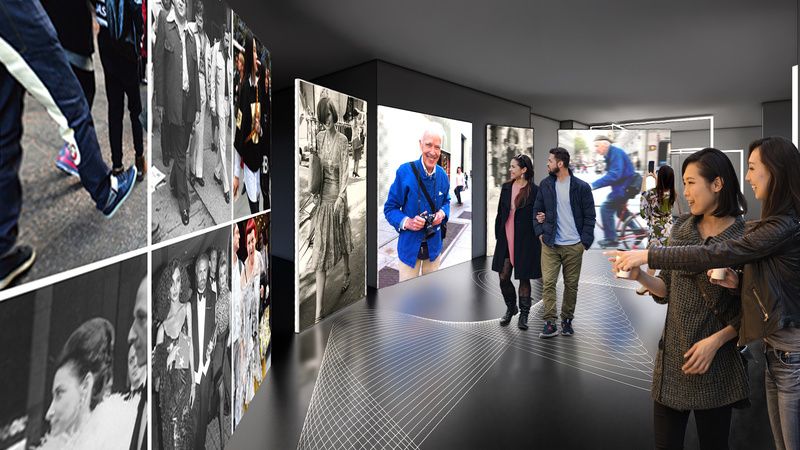
Located at 26 Fulton Street at the South Street Seaport, Experience The Times of Bill Cunningham transports viewers into the vibrant world of famed street photographer Bill Cunningham. Today, Cunningham is known for his photographs of world-renowned personalities such as Jacqueline Kennedy Onassis, Anna Wintour and Andy Warhol on the streets of Manhattan. Over six decades, Cunningham captured shots of celebrities across a wide variety of environments including fashion shows, social events, and on the streets of New York City. The exhibit is inspired by The Times of Bill Cunningham, a 2020 acclaimed documentary by Mark Bozek and hailed by the Hollywood Reporter as being “a snapshot of a life that leaves you grateful for having encountered it.” Experience The Times of Bill Cunningham was designed by NBBJ’s New York Experience design studio, ESI Design and co-presented by Live Rocket Studio founded by Bozek, Creative Edge Parties and Blue Note Entertainment Group.
To bring the photographer’s work to life, Experience The Times of Bill Cunningham will feature large-scale reproductions of Cunningham’s most iconic photos, video, and audio interviews — including artifacts like Cunningham’s iconic Biria bicycle and his trademark blue french worker’s jacket. Across two stories, 18,000 square feet and six distinct faces, the exhibit will also showcase a grand staircase where guests’ outfits will be digitally transformed into a one-of-a-kind fashion statement. Additionally, guests can pose on a simulated city crosswalk just like the subjects in Cunningham’s work or relax on a bench made of milk crates and a foam mattress — alluding to the artist’s bed in his Carnegie Hall studio. Launching September 12 for Fashion Week, Experience The Times of Bill Cunningham will run through October 30, 2021.
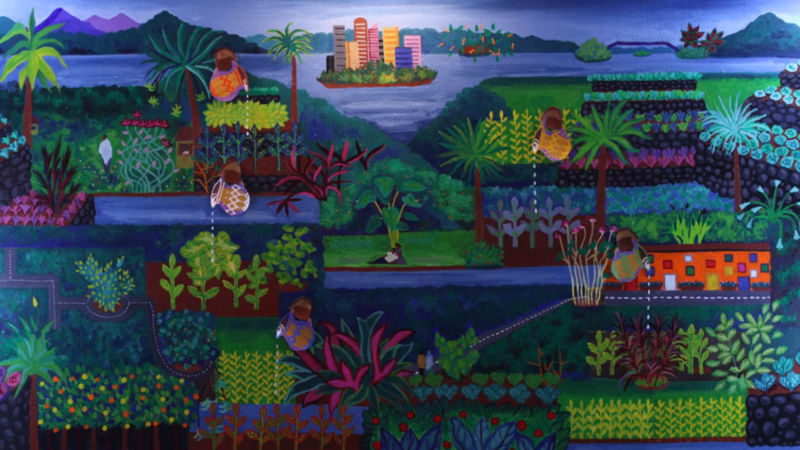
During the month of September, Times Square Arts will present Possible World by Ezra Wube. The painted animation will be part of the Times Square Arts Midnight Moment series, airing across 75 electronic billboards throughout Times Square from 11:57 to 12:00 p.m every day. Possible World was created as part of Fast Forward — Little Sun’s series of short films exploring five artists’ dreams for a regenerative world. Inspired by interviews conducted with over 100 individuals across Ethiopia, Possible World works to bring these subjects’ dreams for a more sustainable world to life. It begins with a focus on current sustainable practices before moving to explore other measures to create a healthier future for the Earth. For viewers, Possible World also asks them to consider what a more sustainable New York City might look like.
For Wube, “Growing up in a country where over 80% of the population’s livelihood depends on agriculture — mostly rain-fed — its socioeconomic dependency is extremely vulnerable to the rapid climate change we are facing. I chose to explore the subject as a means to investigate and learn about these conditions, and to have a communal dialogue of possible solutions. I’m inspired in creating work through community engagement where individuals’ voices can be a potential catalyst for actions to develop a sustainable world.”
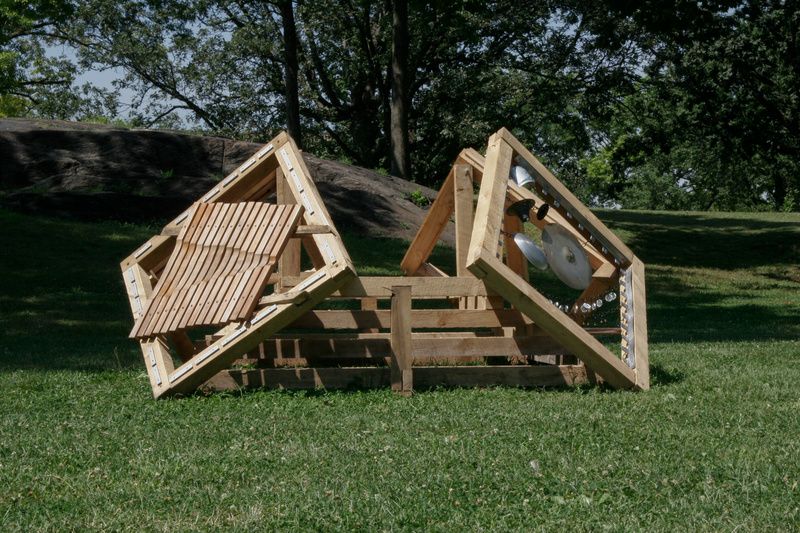
Created by Sean Desiree, Beam Ensemble is an outdoor orchestra that combines the artist’s understanding of timber frame construction with music production. It connects its viewers more deeply with the buried history of African American composers. As a result of discriminatory practices that denied African Americans access to revenue, venues and equipment needed to be successful in the field, most African American classical composers have been largely forgotten. As a result, Beam Ensemble intends to celebrate the work of composers such as Nathaniel Dett, William Grant Still and Florence Price.
Each of the four distinct sections of the orchestra will be based on a different instrument originating from the African diaspora. Included instruments will be the kora, percussion, an amadlina and a tongue drum. Commissioned by More Art through the Engaging Artists Residency program, Beam Ensemble will give orchestral music back to the people by providing a resource to foster their compositions. It will be on display from through October 26, 2021, at Crotona Park in the Bronx.
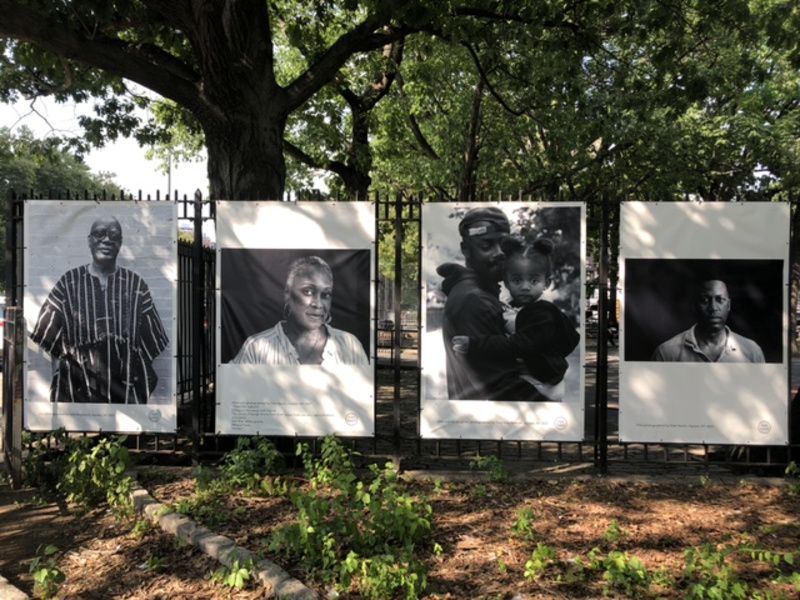
Curated by Sade Boyewa El and Kate Sterling, Faces of Harlem is a multi-site outdoor photography installation. The project features 100 portraits of Harlem friends and residents, helping to document what the neighborhood has become 100 years after the Harlem Renaissance. Preparation for Faces of Harlem began in early 2021 when nine additional photographers from Harlem were invited to create portraits of the neighborhood’s residents to spark conversation, foster connections and build bridges between the community’s visible gaps. Particular emphasis was placed on highlighting work and people often underrepresented in Harlem, with an extra focus on the neighborhood’s African American and diasporic cultures.
Open through October 31, 2021, portraits from Faces of Harlem will be on display across four parks in Harlem: Morningside, Jackie Robinson, Marcus Garvey, and Rucker parks. Events pertaining to the installation will occur on the first Saturday of every month. Visitors will be given opportunities to respond to the images on view and share their own unique perspectives.
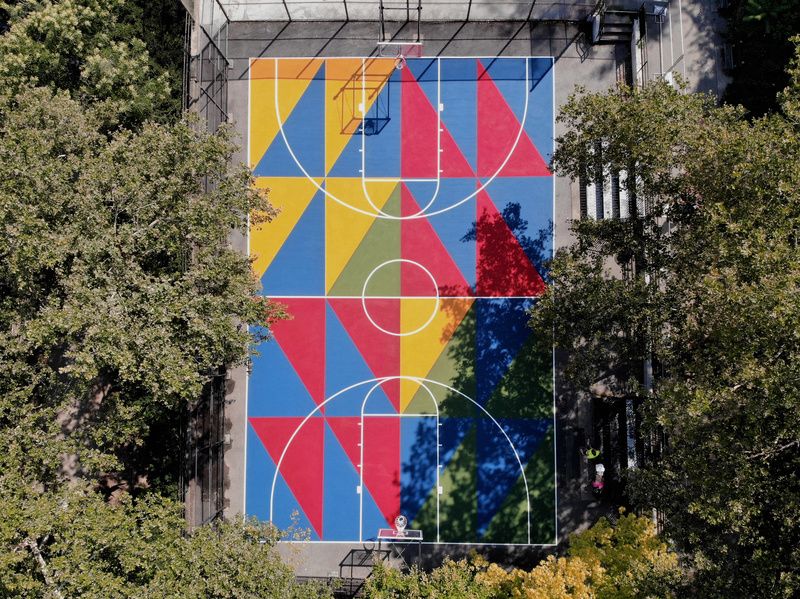
In a basketball court at St. Nicholas Park in Manhattan is Faith Ringgold’s muralWindows of the Wedding #1: Woman. The mural is part of Ringgold’s ongoing Windows of the Wedding series, which began during the 1970s after the artist began experimenting with abstract shapes. Ringgold would go on to receive critical acclaim during the 1980s for her narrative quilts.
Presented by Project Backboard, Windows of the Wedding #1: Woman’s design features a vibrant array of colors painted next to one another in triangle shapes of various sizes. It will be up for view through August 8, 2022.
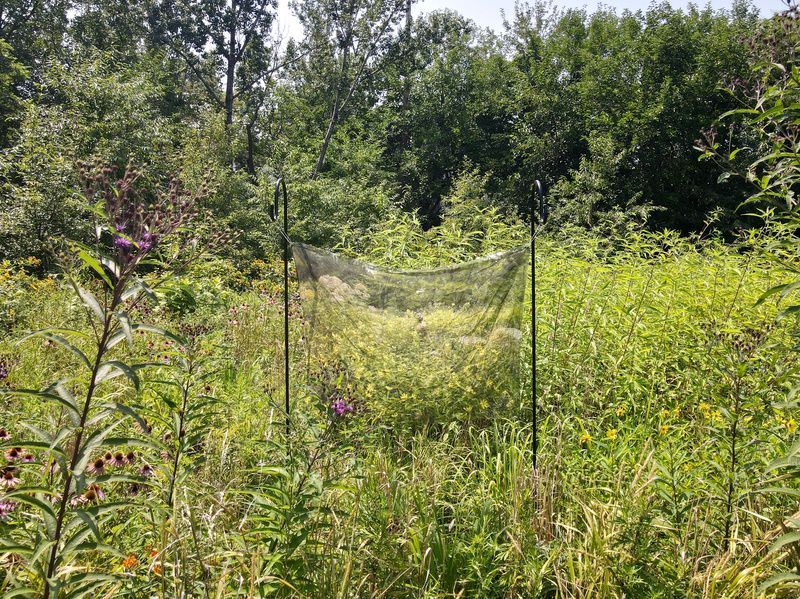
Open just until September 2nd at the Naval Cemetery Landscape in Williamsburg, the exhibition Solitude: In a Landscape is on display by artist Najee Wilson. The exhibition features a film centered on the celebration of bucolic beauty within an urban oasis, made possible with support from the New York City Artist Corps and Brooklyn Greenway Initiative. Shot in the Naval Cemetery Landscape one year prior, Solitude: In a Landscape contrasts directly with the chaos of 2020 to bring viewers a sense of comfort and nostalgia for nature. Live music for the film wasscored by musician Ben Brown of Hand and Temple.
As visitors walk along the boardwalk, they can view stills from the film that have been printed on silk and hung from shepherd’s hooks. In doing so, the stills float above the meadow, with this being amplified by surrounding wind chimes which provide an additional chorus of sound.
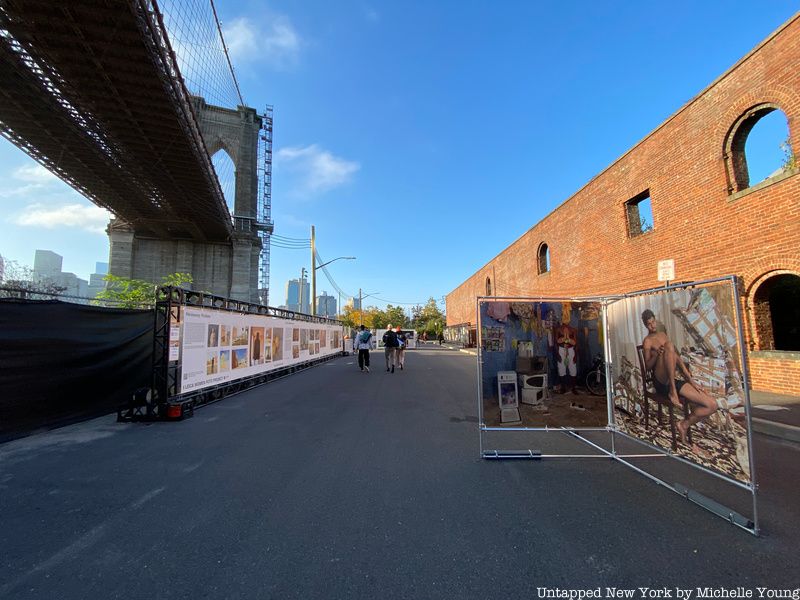
Founded in 2011 in Brooklyn, Photoville is a New York-based non-profit organization that works to promote a wider understanding and increased access to the art of photography. The organization was built on the principles of addressing cultural equity and inclusion in the art world with a focus on incorporating these practices in relation to gender, class, and race. Specifically, Photoville works to activate public spaces with the goal of giving visual storytellers a venue to tell their stories and viewers a chance to broaden their views on the artistic field.
This year, on September 18, the Photoville Festival will return to New York City for its 10th anniversary. As New York City’s free premier photo destination, the Photoville Festival will feature virtual online storytelling events, artist talks, workshops, demonstrations, educational programs, community programming, and open-air exhibitions across parks and public spaces. One exhibition at the festival will be Women in the Face of History — presented by the Department of Photography & Imaging and the 370 Jay Street Project at New York University to showcase America’s complicated history of suffrage. A second exhibition included in the programming will be Signs of your Identity — a selection of portraits of Native American, Alaska Native, and Native Hawaiian survivors of the US government’s Indian Boarding School system by artists Catherine Blackburn, Gregg Deal, Mo Thunder, and Daniella Zalcman. The festival will run through December 1, 2021.
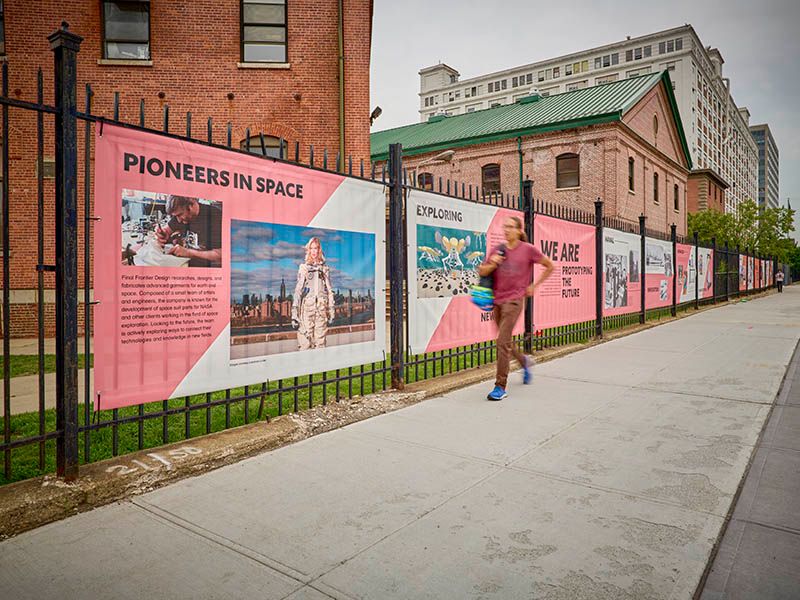
Along half a mile of the Brooklyn Navy Yard’s fence line on Flushing Avenue is Art & Object Walk — a collection of 150 large-scale photographs of Yard-made artwork and furniture. The photographs can be viewed on Flushing Avenue from Elliot Place near Wegmans grocery store to Building 77 located at Vanderbilt Avenue. Much of Art & Object Walk’s work centers around four main themes: sustainability, technological advancements, art, and innovators — with each focused on the theme’s unique connection to the Brooklyn Navy Yard. As an example, pieces under the technological theme feature works created at the Yard such as space suits, state-of-the-art sports helmets, the Velox robot, and electric car charging hubs. Another important theme in Art & Object Walk is “We Are,” with the exhibition featuring 15 variations on it. Each panel under this theme highlights eight to fifteen artists or creative businesses with photographs that illustrate artistry, craftsmanship, and skilled production that occurs every day at the Brooklyn Navy Yards.
Other panels in the installation feature images of “NYC firsts” such as the Kings County Distillery — the first distillery since Prohibition — and Brooklyn Grange — the first operational rooftop farm — in the city. Some panels also highlight city traditions with one example being woodworking from shipwrights that today is continued by furniture makers in Wallabout Bay. Moreover, certain pieces also paid particular attention to the Yard’s efforts to produce Personal Protection Equipment (PPE) during the COVID-19 pandemic. Overall, Art & Object Walk aims to highlight the Brooklyn Navy Yard’s range of innovation across multiple sectors, doing so by highlighting the work of innovators, artists, designers, makers, and businesses that call the Yard their home. Art & Object Walk compliments earlier site-specific artwork inside Buildings 92 and 77 and will run through December 2021.
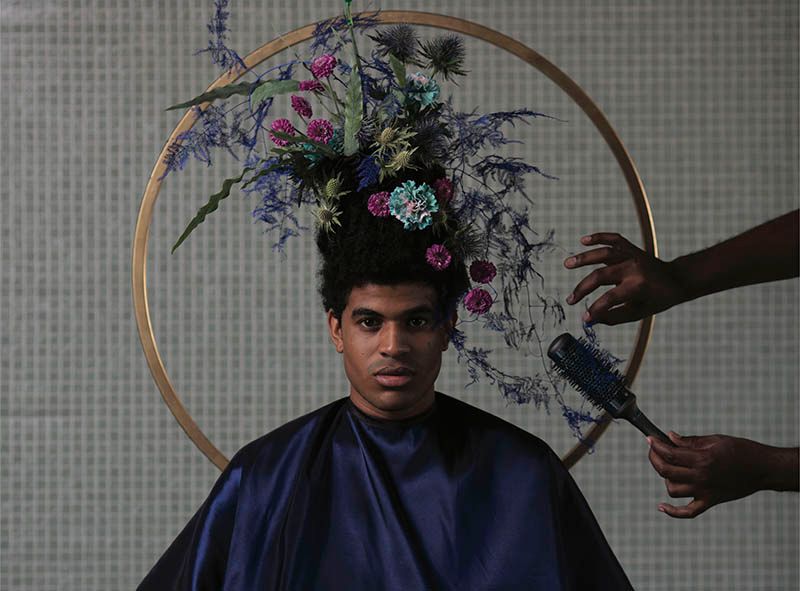
Rockefeller Center and the Art Production Fund will continue its Art in Focus partnership by presenting a public art installation by Los Angeles-based floral artist, photographer, and founder of Bloom & Plume, Maurice Harris. On view from September 7, 2021, the series of photographs installed at Rockefeller Center are primarily from Harris’ Shades of Blackness Vol. 2 #untouched #nofilter #naturalopulence and Shades of Blackness Vol. 3 Don’t Touch My Hair series. In particular, both series aim to investigate how people of color find their beauty and agency — a journey which Harris himself has and continues to undertake.
A selection of the images in the installation will be presented as vinyl murals and feature portraits of family and community members cast by Harris for their natural beauty. They will be set against a backdrop of gold surrounded by floral compositions assembled by hand — giving each piece a human touch. Empty floral frames alongside the images will also push viewers to consider themselves within the installation. This section of the installation will be located at 10, 30, and 50 Rockefeller Plaza, the street and concourse levels of 45 Rockefeller Plaza, and outside of Rockefeller Plaza. In addition, a mixed-media portion of the installation will be placed in the vitrine spaces of the lobby at 45 Rockefeller Plaza. It will highlight Harris’ niece Elyse, who the artist considers to be his muse. Through creating full-size portraits of Elyse set among lush foliage, Harris hopes to reframe the black experience and showcase a world in which the violence typically inflicted upon women of color does not exist.
Tucked right on the border of Bushwick and Williamsburg at 455 Jefferson Street is Undercurrent, an immersive audiovisual and multimedia exhibition that will bring together over 60,000 square feet of original art installations by influential musicians. Opening on September 9, 2021, Undercurrent’s installations will feature work by more than 40 artists, creatives and nonprofits, including Bon Iver, Grimes, The 1975, Jorja Smith, Khruangbin, Miguel, Actress, Aluna, Jayda G, Mount Kimbie,= and Nosaj Thing.
All of the installations are centered around the climate crisis, aiming to inspire its audience to take action. Driving forces for the exhibit include climate change-focused nonprofits Kiss the Ground, Ocean Conservancy and Global Forest Generation. In addition, visitors will be able to enjoy sourced farm-to-cocktail beverages and peruse a curated collection of sustainable wares during their visit to Undercurrent. Tickets can be purchased in advance online for $45, with children 5 years and under entering for free.
Continue reading to see what is still on display from previous months in NYC!
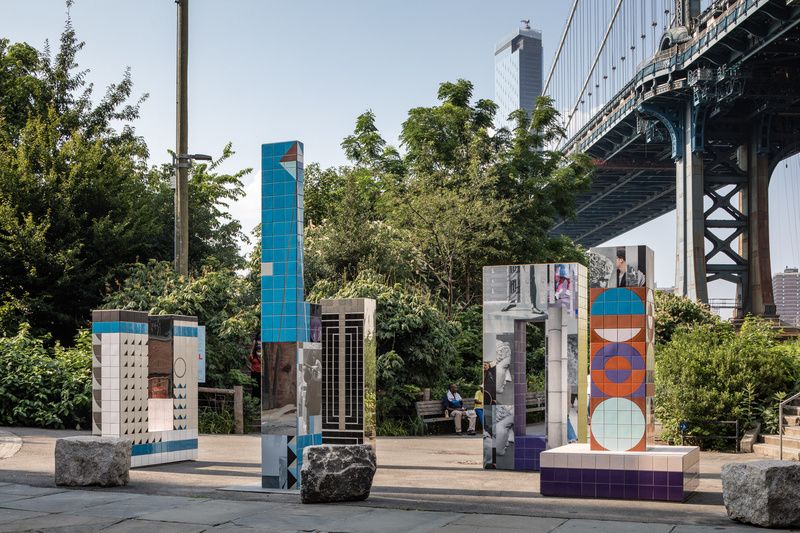
Scattered around the iconic terminus of Washington Street in Brooklyn Bridge Park’s Main Street Park section — where the Manhattan Bridge perfectly frames the Empire State Building — is Rehearsal, the public debut for Berlin-based artist Claudia Wieser. Presented by the Public Art Fund, Rehearsal will feature five distinct large-scale geometric sculptures made from mirror-polished stainless steel, reflecting the movements of visitors as they pass by. Ranging in height from 7 to 13 feet, the sculpture’s warm and cool-toned hand-painted glazed clay tiles define each sculpture. At the same time, they also echo the patterns of neighboring historic red buildings and Belgian-block paving stones. As a further connection to its surroundings, Rehearsal includes contemporary photographs of New York City and slides of a German family’s trip to the city from the 1980s. Reproductions of ancient Roman and Greek antiquities endow the installation, serving as a meeting place and theatrical setting much like ancient Roman forums once did. Moreover, the title ‘rehearsal’ draws attention to the interplay between visitors and artwork, suggesting that the sculptures and even life itself are ever-evolving processes. Rehearsal will be on display until April 17, 2022.
As Public Art Fund Associate Curator Katerina Stathopoulou (Rehearsal’s curator) states in the artwork’s press release: “Wieser is acutely aware that the sculptures will become part of the landscape of the city for a time and wanted to create a powerful synergy with the bustling surroundings of DUMBO. Building a dialogue between the public and the sculpture is an integral part of Rehearsal… Park-goers will activate the works by touching, resting, and seeing themselves and the city reflected as they weave their way through the constellation of sculptures.”
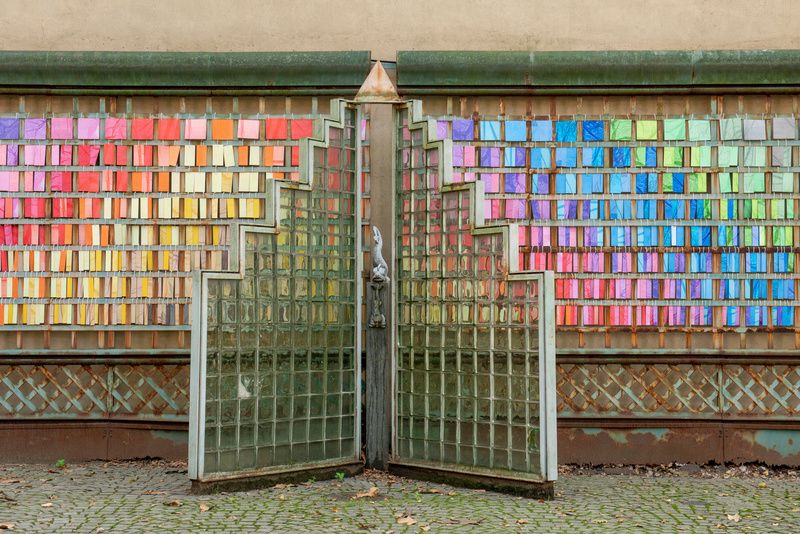
While walking through Harlem Art Park, visitors can marvel at Capucine Bourcart‘s Plastic Fantastic. Measuring 66-feet wide and 7-feet high, Plastic Fantastic’s grand scale illustrates the abundance of single-use plastic and how it has adversely affected our environment and public spaces; New York City residents are estimated to use more than 10 billion single-use plastic bags a year. Plastic Fantastic aims to support the city’s current ban on plastic bags while encouraging residents to take responsibility for their environmental footprint.
To convey this, the installation features plastic bags collected over the last few years by Bourcart from community residents and neighbors. To create Plastic Fantastic, these bags were photographed and printed on 4’ x 8’ sheets of D-bond, a lightweight and durable plastic material. Afterward, the sheets were cut into smaller squares and rectangles to create a color gradient woven into the grid of the park’s ornamental fence. In front of the gradient is a glass block structure which perfectly reflects the colorful background. Funding for the installation was provided by the LMCC, Puffin Foundation, and Friends of Art Park Alliance. Plastic Fantastic will be on display through June 26, 2022.
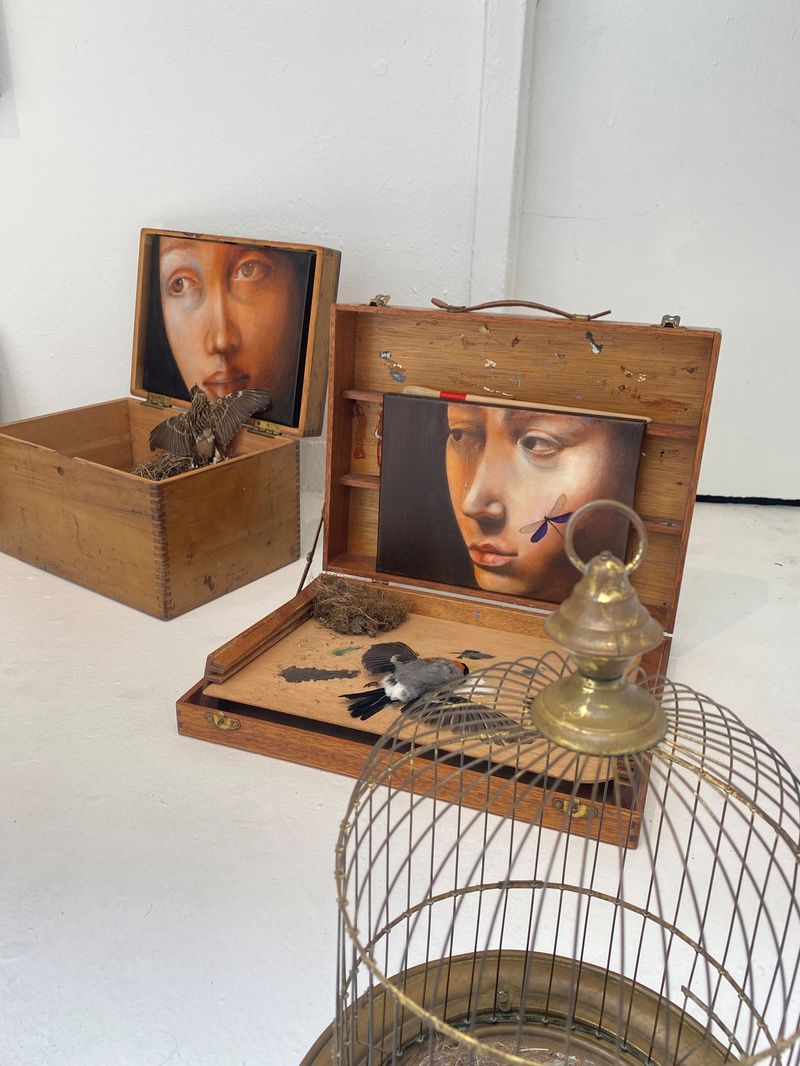
Through September 9, the Garment District Alliance will present The Magician’s Daughter (is a Painter) — a series of paintings nestled within “magical boxes.” Created by painter and multi-media illustration artist Cheryl Parry, the free exhibit is located in a street-level window at 215 West 38th Street. Parry was inspired to create The Magician’s Daughter (is a Painter) by her father and his love for magic. Each painting in the exhibit is decorated with preserved birds, dragonflies, and nests tucked within magic boxes. The Magician’s Daughter (is a Painter) serves as part of the Garment District Space for Public Art program, which over the past 16 years has presented over 200 installations, exhibits and performances showcasing the work of artists in unusual locations across the city.
In the words of Barbara A. Blair, president of the Garment District Alliance: “Through a personal and emotional display, The Magician’s Daughter (is a Painter) brings together art and magic to create fascinating illusions.”
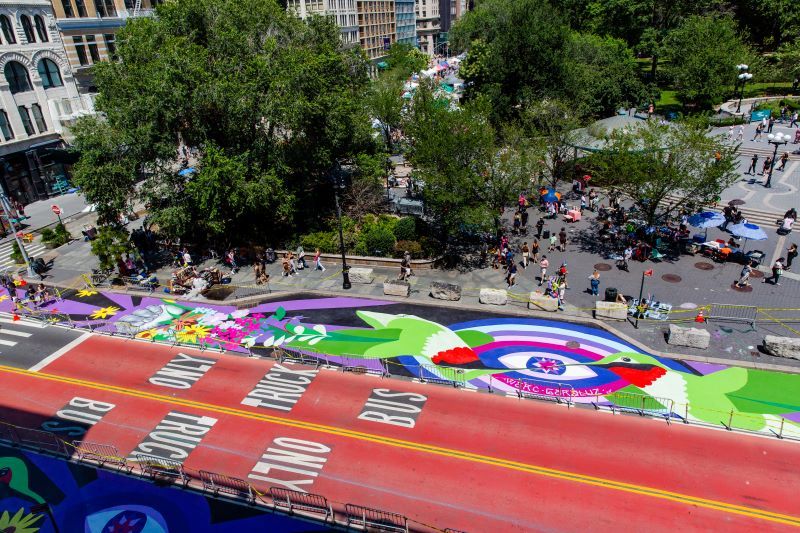
Collective Vision is a 7,500-square-foot mural presented by street artists Geraluz and Werc (a Brooklyn-based couple) painted in the pedestrian areas of the 14th Street busway between Broadway and Union Square West. Presented by the Union Square Partnership and the New York City Department of Transportation’s Art Program, the mural addresses themes of nature, unity and resilience. It will be installed over the course of 4-5 days beginning July 27 with the help of 20-30 volunteers who will hand-paint the large shapes and background colors.
Collective Vision works to recognize the history of social movements fighting for justice within Union Square and the larger struggle for racial equality in the United States. As an example of this, the mural includes a striking rendition of the Black power fist surrounded by an array of vibrantly colored flowers. At the same time, the mural will also celebrate the community that public spaces have helped shape and their role in fostering activism and collective experiences.
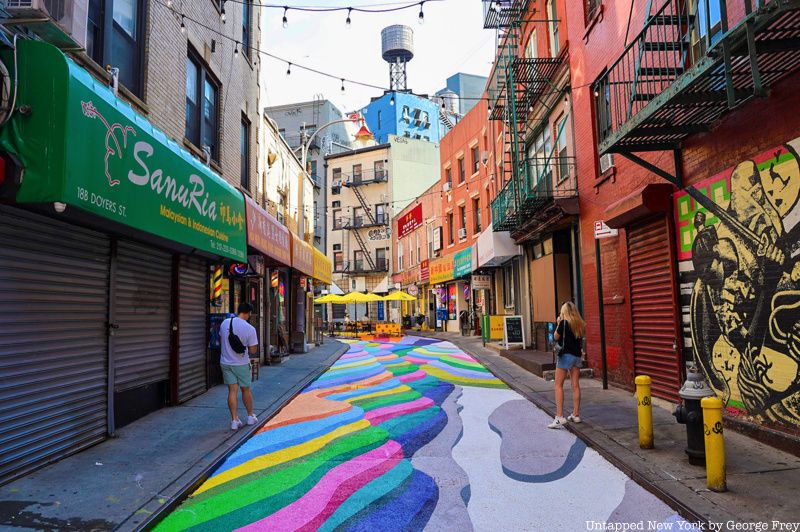
In honor of Pride month, Chilean-born street artist Dasic Fernández painted the historic Doyers Street in Chinatown in a range of beautiful colors from all across the rainbow. In the past, Doyers Street was once known as “the Bloody Angle,” for the amount of gang violence that took place in the early 20th century. The breathtaking mural that now covers the street spans 4,851 square feet in length and includes 44 unique colors, painted across a period of just three-and-a-half days. Fernández received information for the mural’s design from rice cultivation terraces—a common landscape seen throughout China. Using the Anamorphism technique, the mural appears 3D at certain points, most notably from the corner of Pell or Bowery streets, perfectly integrating the mural into its surrounding environment.
Doyers Street’s vibrant makeover is part of New York City’s Asphalt Art Activation series, which involves the partnership between NYC Department of Transportation (DOT) and artists to paint large scale-murals onto repurposed asphalt that are pedestrianized public spaces. Typical sites the program has transformed include curb extensions, slip lane closures, bike share lanes, and temporary plazas, with sizes ranging anywhere from 1,000 to 8,000 square feet. In addition, as part of the city’s Open Streets program, Doyers is fully closed to all vehicular traffic from Bowery to Pell streets daily from noon to 11:00 p.m. Given this, Doyers Street serves as the perfect venue for visitors to walk through and enjoy Fernández’s mural. The mural will be on display for the following 11 months, weather permitting.
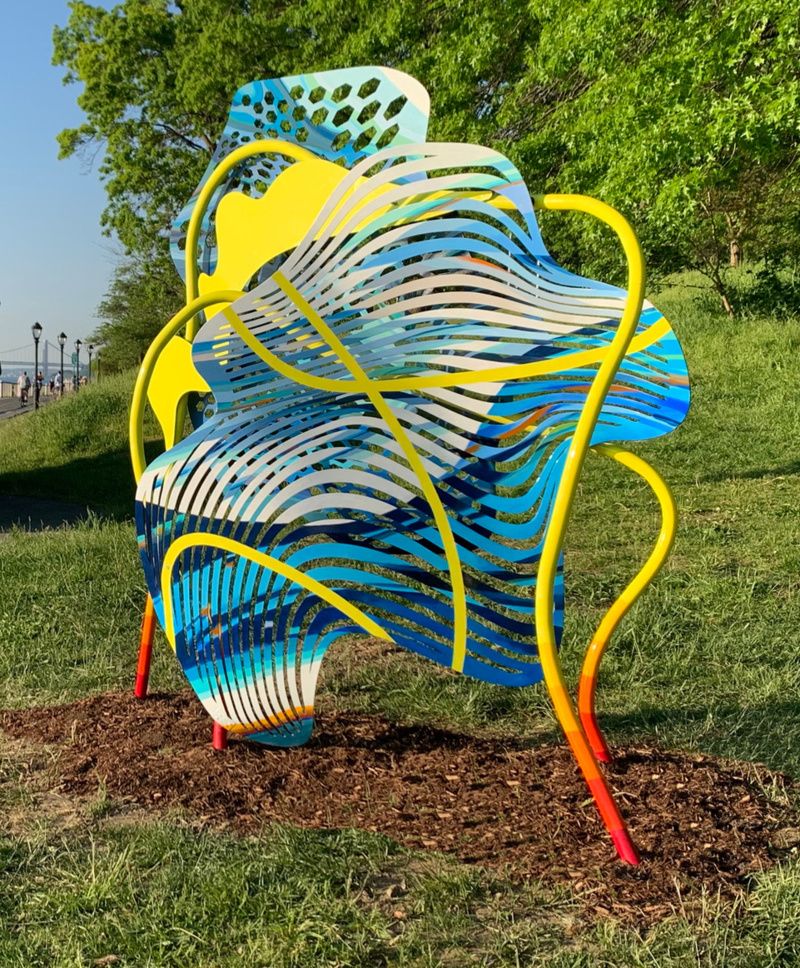
This summer, New Jersey-based multi-disciplinary artist Wendy Letven will have two sculpture works on display in Riverside Park as part of Karin Bravin’s Re:Growth public art exhibition. The first, There Are Holes In My Perception Of The Forest, located at 125th and Riverside Drive, features an aluminum-cut structure painted in various shades of blue, brown, green, and yellow. The structure’s holes allow in the careful flow of light work to evoke the sensation of dappled light and the swirling effect of wind on trees. In addition, the artwork intentionally uses negative space to connote gaps in Letven’s perception of the world around her and the presence of the unseen forces of nature at work.
Letven’s second piece, Four Currents, is located at 83rd Street on the waterfront. It was conceived to represent the convergence of energies surrounding Riverside Park — the flow of the Hudson River, the park’s urban surroundings, the energy of the sun, and the area’s powerful wind forces. Both sculptures will be on display through September 13, 2021.
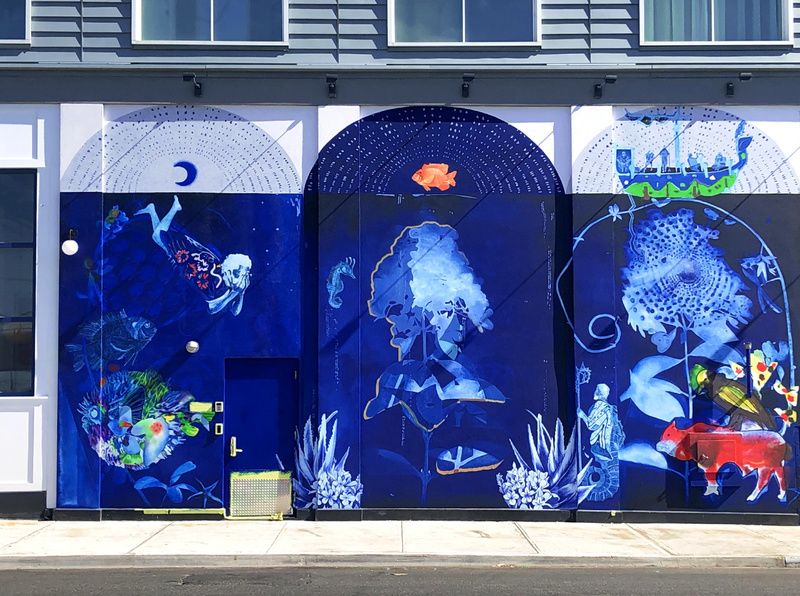
The Fabulous Plant of Rejuvenation is a 90-foot-tall mural by Baxter St alum Ivan Forde, located on the façade of the newly built Rockaway Hotel in Rockaway Beach, Queens. The mural was curated by Michi Jigarjian, Managing Partner, Creative/Social Impact Officer, with support from 7G Foundation and Facebook Open Arts. Inaugurated on June 18th, 2021, the artwork draws inspiration from the legacy of Rockaway‘s’ Indigenous Lenape people and Forde’s own ancestry — including conversations with his father on the healing powers of water and vegetation. Included in the mural is a depiction of an underwater seascape of poetic sea characters alongside local fish and birds. Its centerpiece is the mythical plant from the ancient Mesopotamian poem The Epic of Gilgamesh. In addition, the mural features a series of healing plants, connected to Forde’s birthplace of Guyana, the Rockaways, and other cultures across the globe.
“My project takes cues from the structures of epic poetry, conversations with ecologists and botanists, and folk traditions our grandmothers and great-grandmothers knew,” Forde said. “These knowledge systems are paramount to the discussions the mural aims to hold space for and align with a symbiotic relationship to nature essential for healing both the human species undergoing a global pandemic and the planet itself.”
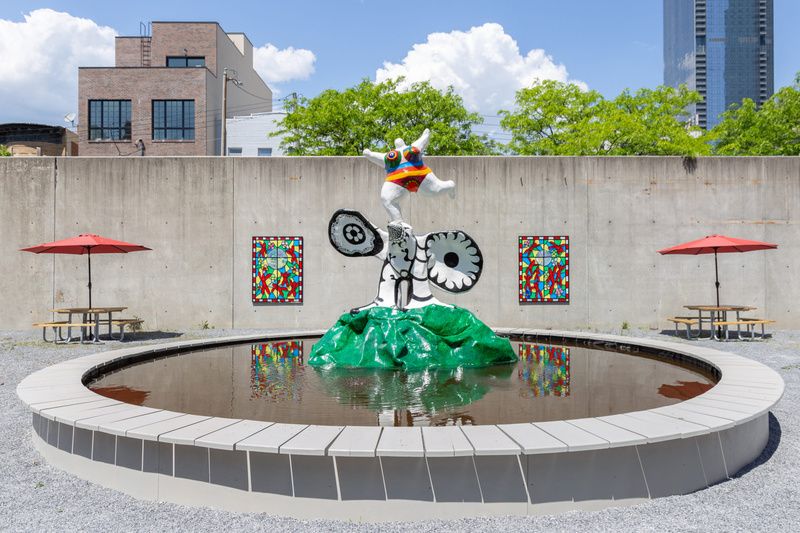
For those visiting the Hunters Point area of Queens this summer, MoMA’s PS1 outdoor courtyard will feature an experiment in creative ecologies. As a leading space within the neighborhood’s community, the new installation will reimagine the use and access of the PS1 courtyard. It will feature Rashid Johnson’s Stage, a participatory installation and sound work, which draws on the history of the microphone as a tool of protest and public oratory. It will feature a yellow powder-coated stage, with Johnson’s signature markings engraved onto it, and five SM58 microphones of varying heights. Stage’s design echoes that of other unofficial sites of public intellectual and cultural life like Harlem’s 135th Street and Lenox Avenue. Visitors will have the opportunity to speak to the public on the stage, with their words being recorded and broadcasted in the courtyard. In addition, the stage will feature a number of performances from artists, activists, poets, and musicians.
Besides Stage, the PS1 outdoor courtyard will also host a series of Thought Collectives that test out new and creative propositions for the future usage of public spaces. One of these collectives will be Niki de Saint Phalle‘s 1967 sculpture La Femme et L’oiseau fontaine, part of a survey of Saint Phalle’s work Structures for Life on display through September 6th, 2021. The sculpture serves as a perfect example of the artist’s early Nana sculptures, which served as monuments of female empowerment and symbols of the growing movement to move the display of artwork outside the confines of indoor art galleries. Finally, along the wall surrounding Saint Phalle’s sculpture will be Raul de Nieves’ 2021 installation, The Stories of the Past Rejoice through Children’s Skies. The installation was influenced by Mexican craft traditions, with its structure resembling that of stained glass windows — forcing its viewers into a church-like space of reflection.
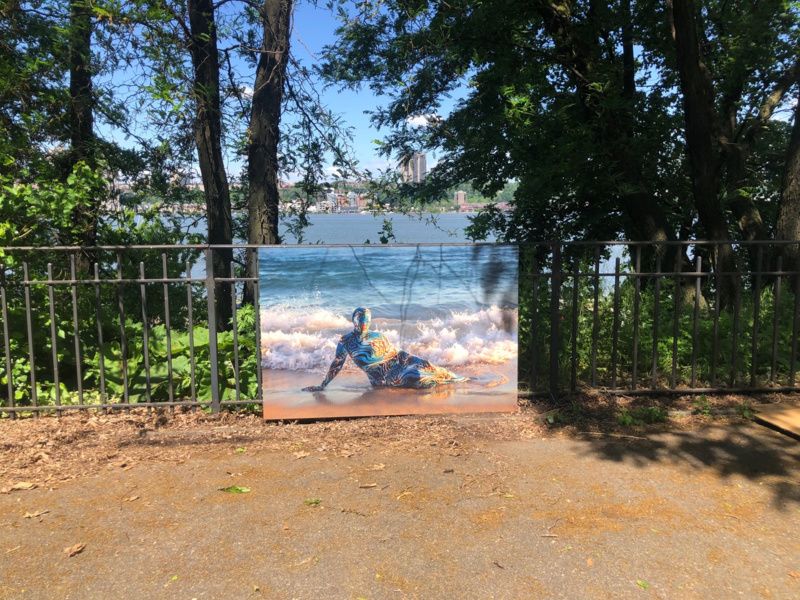
Throughout Riverside Park, passersby can search along the pathways for select photos from Joiri Minaya’s Containers series, as part of the Re:Growth program. Containers is a set of photographs, videos, and performances in which women wear bodysuits with prints that mimic tropical nature while interacting with man-made landscapes that appear natural at first. In each piece, the performer is made to adopt a pose that fits with the shape in which the bodysuit has been constructed. These poses originate from images found while Google searching the term “Dominican women.” In each piece, Minaya directly incorporates her Dominican culture through their jungle and beach-inspired backgrounds that reflect her country’s tropical climate. In essence, Containers aims to reflect on the constructions of femininity in our modern society in relation to nature as it is imagined through the male gaze
Additionally, the placement of the performers’ images within the city’s natural landscape works to bring poignant visual metaphors for immigration, preservation, camouflage, assimilation, otherness, refusal, and (in)visibility into direct conversation with the New York scene. On display in Riverside Park will be Containers 2, 4, 5, 6, and 7.
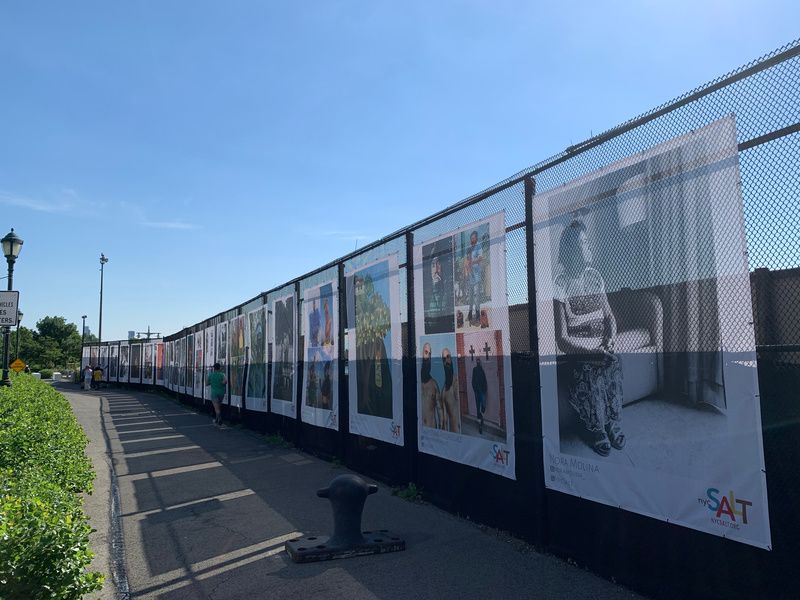
This summer, the local arts non-profit NYC SALT will unveil a new public art exhibition outside the West 30th Street Heliport in Hudson River Park. The exhibition will feature work from young emerging New York City artists who graduated from SALT’s visual arts program for underserved city youth. Curated by Polly Irungu, the exhibition will serve as a direct reflection of NYC SALT’s work, which focuses on engaging students from all backgrounds in a blend of rigorous professional photography instruction, college preparatory workshops, and career exposure into the art world.
The featured students’ work in the exhibition aims to portray their unique perspectives on the dynamic communities within the city of which they are a part. It will include 22 large-scale works displayed on 7-by-9-foot vinyl panels, highlighting their fascination for discovery, play, and documenting visual histories for park-goers. Some of the featured youth artists whose careers have been set in motion by SALT will be Emeraude Dorcelly, Varda Durandisse, Nora Molina, Andrew Morocho, Devin Osorio, and Malike Sidibe, among others.
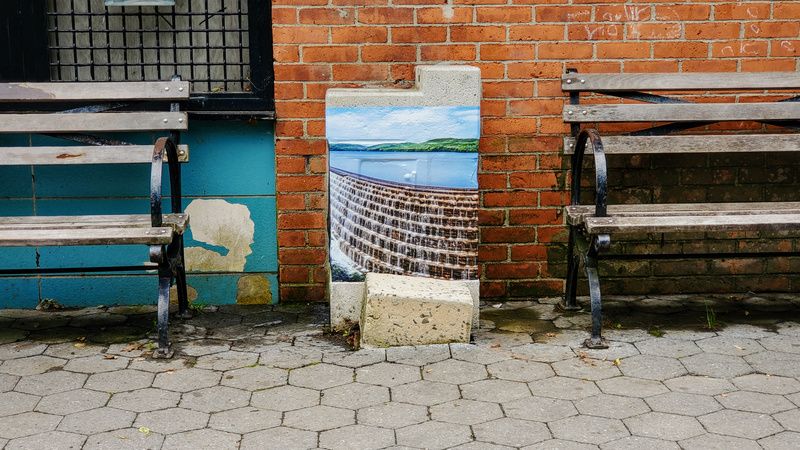
“Source to Spout” — created by multimedia artist and documentary filmmaker Adrian Sas — is a series of panoramic photographs wrapped around drinking fountains across Riverside Park from 64th Street all the way up to 148th Street. Through this series, Sas brings attention to the system of protected lands, reservoirs, and aqueducts that bring more than one billion gallons of water from upstate watersheds to these fountains and New York City’s taps every day.
As part of the NYC Parks Art in the Parks program, Source to Spout connects to Sas’ larger work, which focuses on the connections between people and places. Some places where Source to Spout installations can be found are Red Shade Plaza on 64th Street, Hippo Playground at 91st Street, Riverside Promenade at 120th Street, and the Ballfield dugout at 149th Street. The installation will be on display until October 29, 2021.
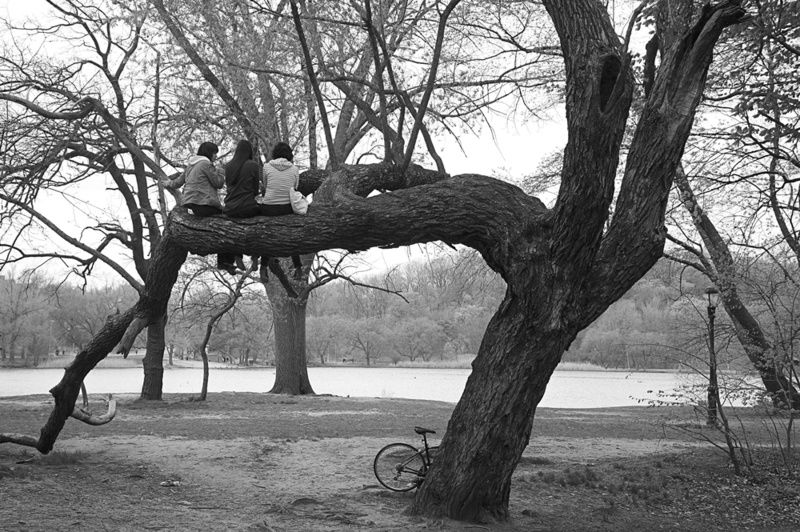
Since 1867, Prospect Park has served as one of Brooklyn’s most influential natural outdoor spaces. In honor of the park’s legacy and the start of restoration on Lefferts Historic House, the Prospect Park Alliance has partnered with the non-profit Photoville to present Jamel Shabazz’s Prospect Park, My Oasis in Brooklyn, a site-specific photo exhibition of the Brooklyn scene. Shabazz is most known for his photography work of New York City during the 1980s which has been widely displayed in The Whitney Museum, The Studio Museum of Harlem, and the National Museum of African American History in Washington D.C.
His new installation, which will be displayed on the construction fencing of the Lefferts Historic House, will focus on photographs of Prospect Park taken over the last 41 years. In these photographs, Shabazz showcases how people have used the park as a means of embracing nature away from the city, with featured images offering views into reunion picnics, musicians, races, and dog walks across the park. The exhibition will be on display through December 1, 2021.
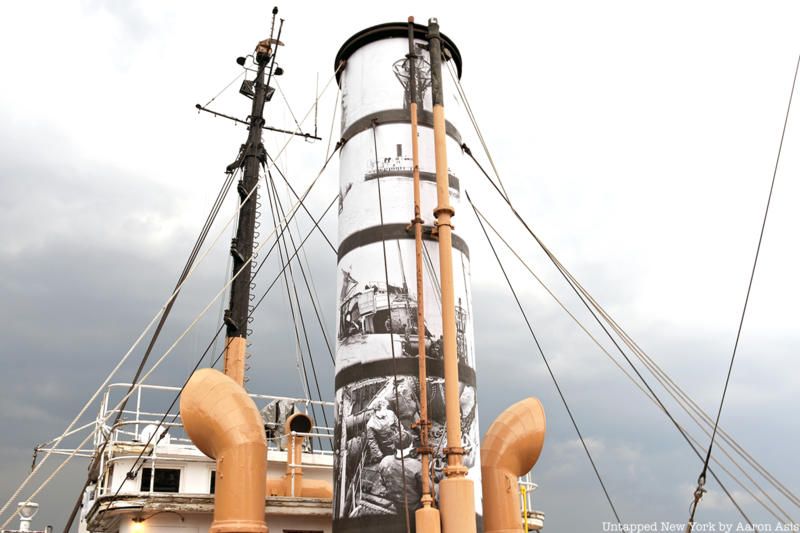
A new mural titled 88 LILAC celebrates the history of the LILAC on Pier 25 in Lower Manhattan. The LILAC is a retired Coast Guard cutter that maintained buoys and carried supplies to lighthouses from 1933-1972. The paper mural, created by Aaron Asis, Untapped New York’s Artist in Residence, displays large-scale historic images wheat-pasted along the ship’s historic stack. When up close, you can listen to a dramatic account of an important moment in LILAC’s history titled “Aids to Navigation,” written by Untapped New York’s Chief Experience Officer Justin Rivers. The public can access the experience via a QR code on Pier 25 while viewing the mural.
As America’s only steam-powered lighthouse tender, revitalization efforts for the LILAC are run by the non-profit LILAC Preservation Project. Its goals are to rehabilitate the ship to operate once again on its original steam engines, promote maritime education, provide a venue for history and art, and offer a community-friendly space for meetings and events. The grand re-opening of the museum ship is slotted for July. In the meantime enjoy a view and a story about its history from the fresh air of Pier 25 in Lower Manhattan.
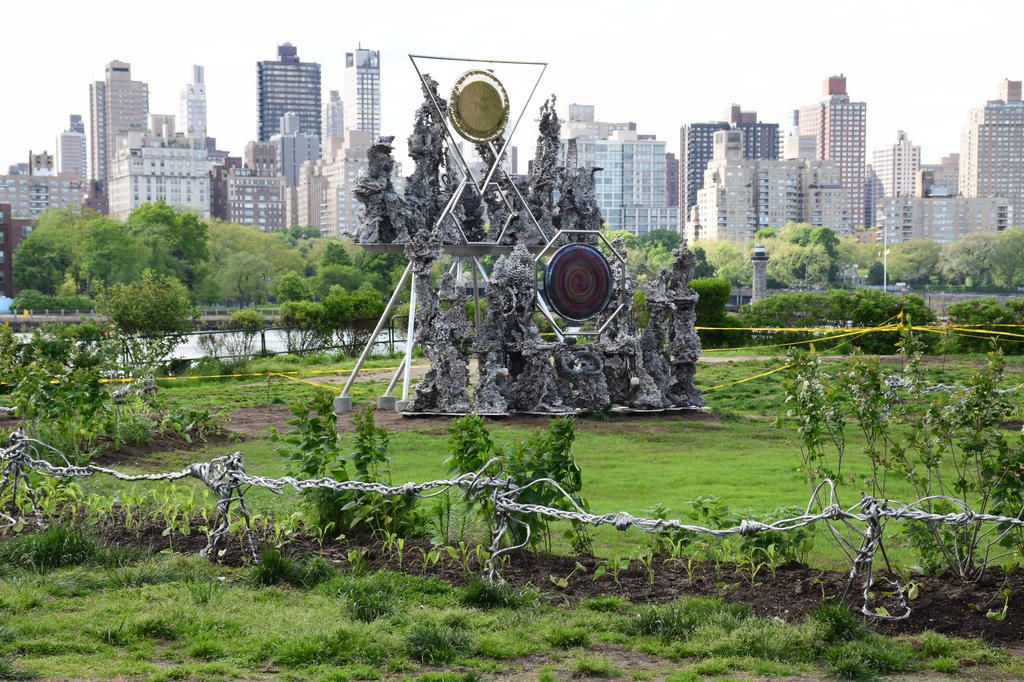
Through Planeta Abuelx, on display at Socrates Sculpture Park, artist Guadalupe Maravilla expands on their interest in Indigenous holistic healing practices through sculpture. The piece was created in response to a curatorial invitation to use the park’s five-acre landscape as a sanctuary for recuperation. Made on-site, Maravilla’s work focuses on physical and emotional health through mutual and holistic care works in harmony with the park’s sheltered green space.
Over the course of the Planeta Abuelx exhibition, Maravilla will activate the projects on view through a series of public programs including community workshops and therapeutic sound baths. The exhibition will be on view through September 5.
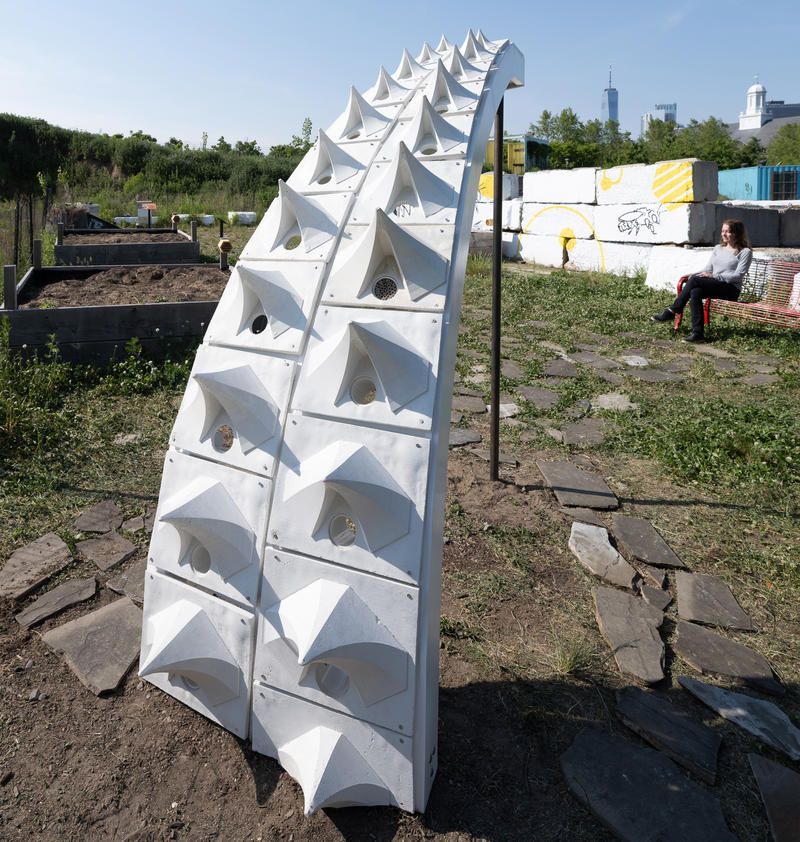
One of the many attractions to the sustainability-focused programming at Governors Island in June is the Pollinator’s Pavilion. The pavilion is a beautifully designed structure for the education and advocacy of climate resilience. The pavilion introduced these overlooked yet critical pollinators to the broad public. A slice of the pavilion will be on view through summer.
Using machine learning, the pavilion communicates data harvested from its monitoring system to collect scientific knowledge on native bees. Created by Pratt’s School of Architecture professor, Ariane Harrison; the Harrison Atelier team, Seth Harrison and Pratt graduate Yuxiang Chen Pollinators Pavilion is an artificially intelligent habitat for native bees helping to promote biodiversity. The public will be able to view the Pollinators Pavilion throughout the summer.
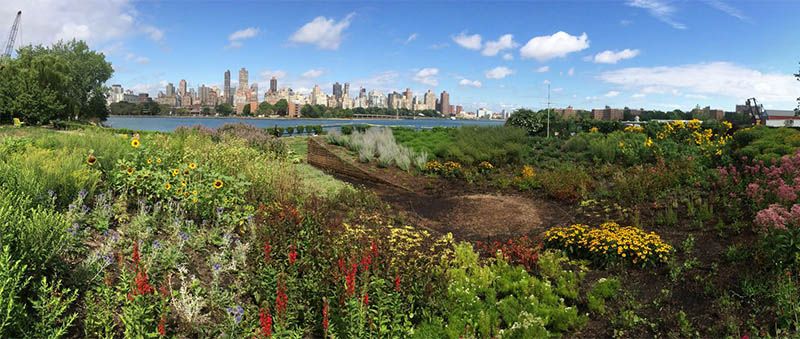
Meg Webster’s art is firmly rooted in nature. For the Wave exhibition at The Arts Center on Governors Island, her work includes visual language of geometric forms and organic matter that enlightens viewers on such topics as nature, ecology, sustainability and technology. Webster’s site-specific installation Wave is comprised of both new and existing work from across Webster’s career. Also on view is work by Onyedika Chuke, an artist and archivist whose ongoing project, The Forever Museum Archive, will be presented in a site-specific display. This most recent iteration of the archive, which joins a unique collection of sculpture, text, and images will feature sculptural work cast by the artist alongside historical artifacts, framed within a labyrinth of Quaker pews.
Conceived by LMCC (Lower Manhattan Cultural Council) as an incubator for creative exploration and a gathering space to engage in dialogue, The Arts Center at Governors Island is located within the Governors Island Historic District, just minutes away from Manhattan by ferry. Both exhibitions take place from June 12-October 31 All programming and events at The Arts Center are free and open to the public with advance tickets required.
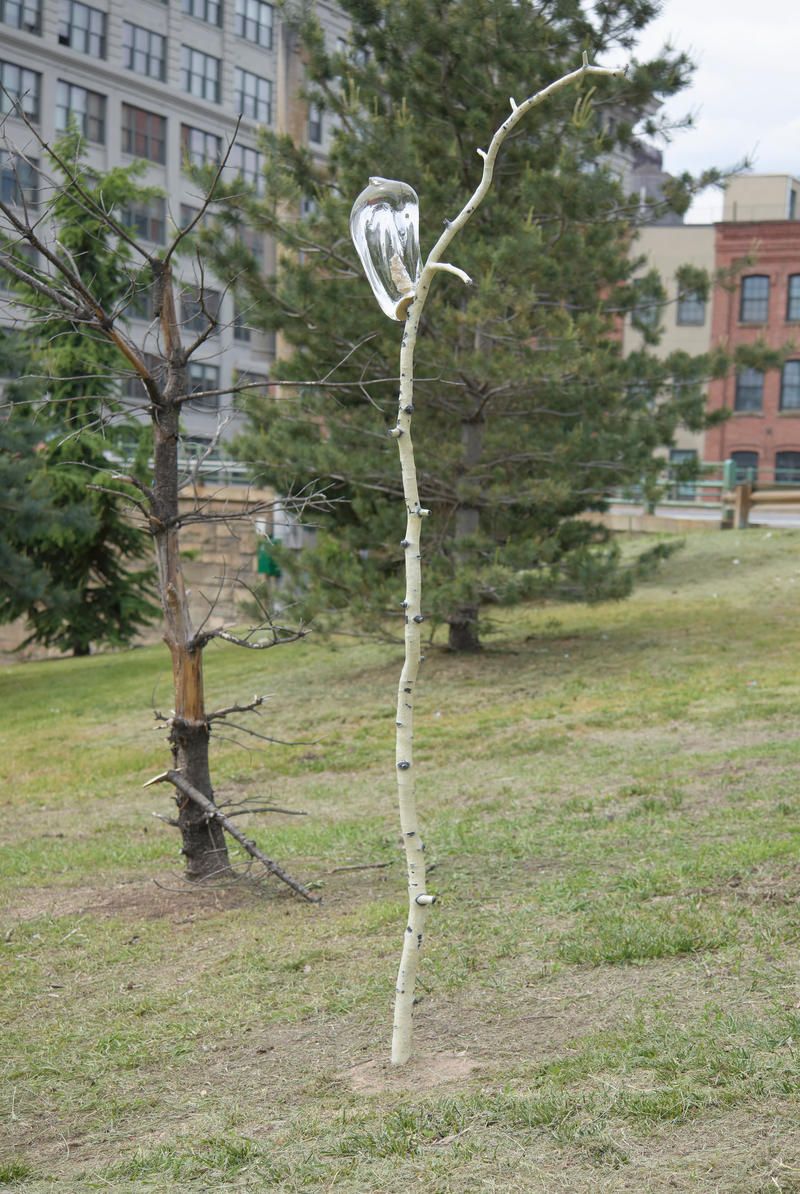
The Roots of Tuckahoe Marble is an 8-foot-tall public sculpture made of Tuckahoe marble, bronze, and glass by Lara Saget. Historically used for building many of New York’s iconic landmarks like Washington Memorial Arch in Washington Square and Manhattan’s historic New York Marble Cemetery, the story and the supply of Tuckahoe marble have been lost.
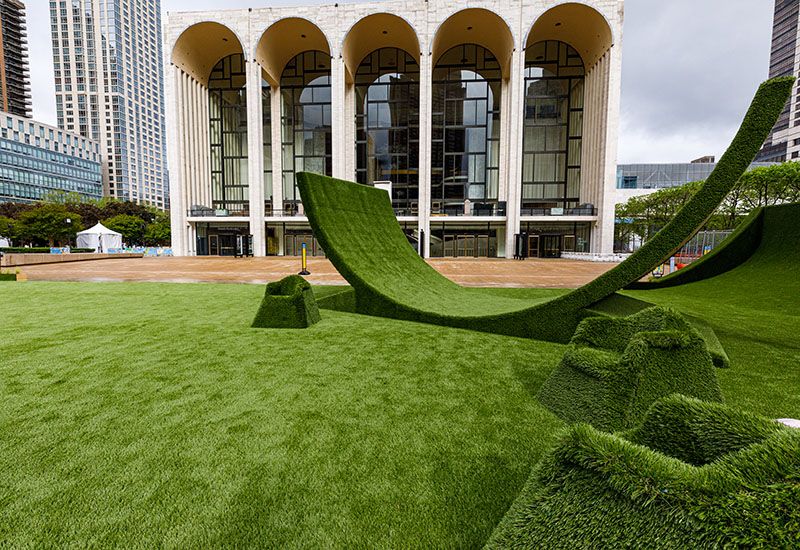
Time to hang outside at “The GREEN” at Lincoln Center. The grass-covered shapes and furniture in the Josie Robertson Plaza encourage you to touch, climb, and relax on this formerly stone plaza. The green space has been reimagined for the summer re-opening of New York by set designer and MacArthur Genius winner Mimi Lien.
The installation acts as the physical centerpiece of Restart Stages, Lincoln Center’s initiative to help kickstart the arts sector and New York City’s revival. “The GREEN” features grass-like recyclable, bio-based SYNLawn material, and is designed in a mobility-friendly way with cane detection for blind or visually impaired people integrated into the architecture.
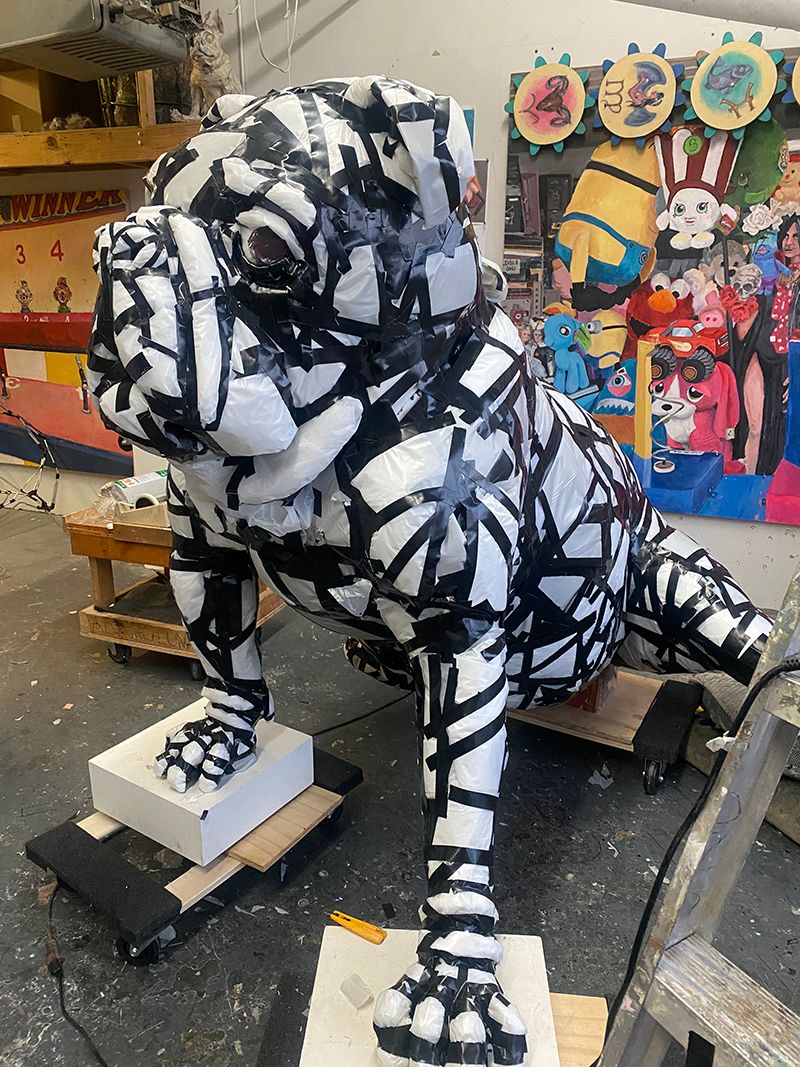
A massive bulldog made of kibble by artist and animal lover Will Kurtz will be guarding Domino Park in Brooklyn for one week in June. The sculpture was commissioned by Freshpet foods and is titled One Sad Kibble Dog. The piece serves as a testimony to the overly processed dry dog food industry. Kurtz’s bulldogs previously stood guard over the Garment District last year.
The nine-foot sculpture was unveiled on June 9 at 5 p.m. and will be there for one week with Freshpet representations on site. Domino Park Dog Run is located at 15 River Street at South Fifth Street.
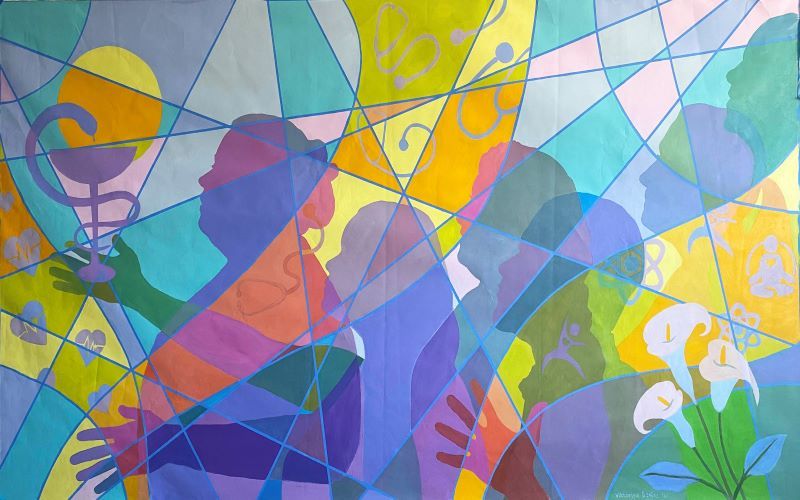
The Community Murals Project of the New York City Health + Hospitals system has unveiled four new murals. Artist Viktoriya Basina created three new murals at Gotham Health/Dyckman Hospital in Inwood celebrating the Dominican community as well as the heroism of the hospital staff. Also unveiled this month is the mural For the People By The People by Daryl Myntia Daniels. Located in the Pediatric waiting room of Gotham Health Sydenham, it depicts notable figures associated with the history of Sydenham and street signs from the Harlem area where the former hospital is located. All the murals were created with community input.
When complete, The Community Murals Project will be the country’s largest public hospital murals program since the Work Progress Administration/Federal Art Project in the 1930s and 1940s. As part of the NYC Health + Hospitals Arts in Medicine program, the project encourages community participation with an artist leader. By the end of summer, there will be 27 murals across the hospital system.
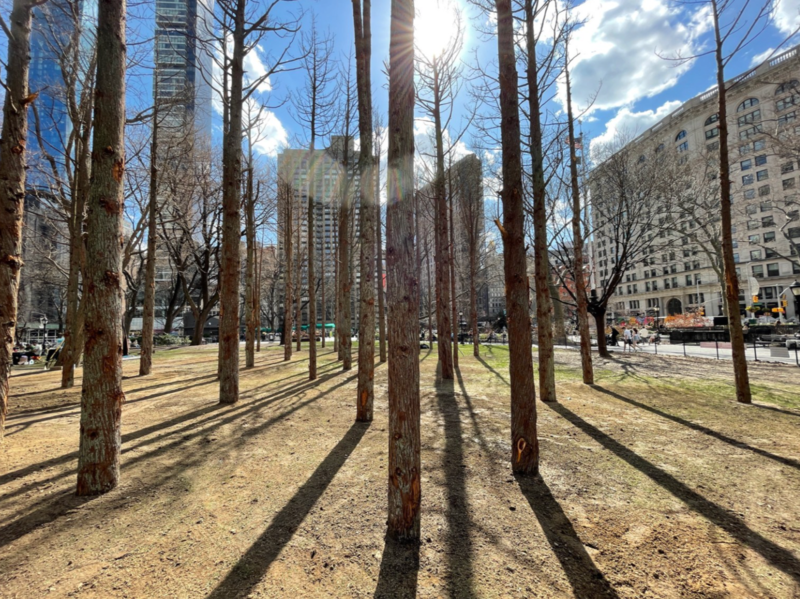
Maya Lin’s Ghost Forest, a towering stand of 50 haunting Atlantic white cedar trees placed in Madison Square Park, is a newly commissioned public artwork. Lin brings her vision as an artist and her agency as an environmental activist to this project, which embodies a memory of germination, vegetation, and abundance, as well as a harsh symbol of the devastation of climate change.
The height of each tree, around 40 feet, stands as a metaphor of the outsized impact of a looming environmental calamity. The trees in Ghost Forest were all slated to be cleared as part of regeneration efforts in the fragile ecosystem of the Pine Barrens, New Jersey. Ghost Forest will be in the park from May 10 to November 14.
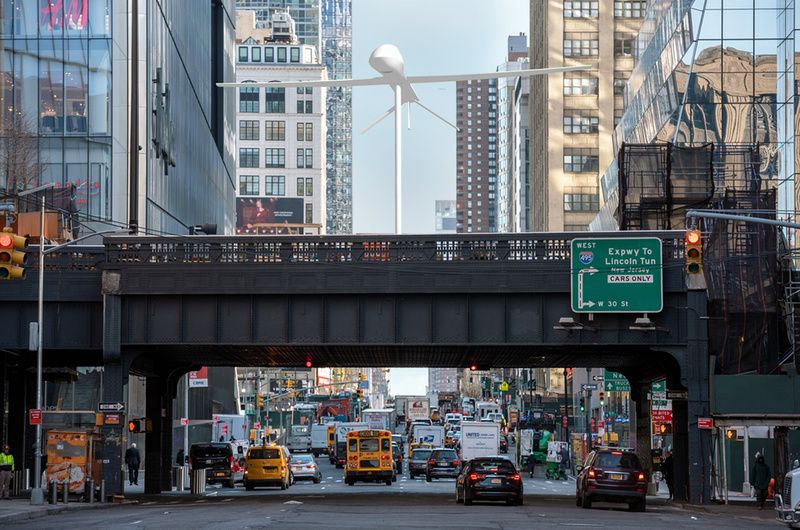
One of several public art installations along The High Line, Sam Durant’s Untitled (drone) is the second High Line Plinth commission. With this work, Durant seeks to make visible the intentionally obscured drone warfare perpetrated by the United States, and to remind the public that drones and surveillance are a tragic and pervasive presence in the daily lives of many living outside—and within—the United States.
This large-scale fiberglass sculpture in the shape of an abstracted drone atop a 25-foot-tall steel pole continues High Line Art’s mission of presenting new, powerful, and thought-provoking artworks that generate and amplify some of today’s most important conversations Untitled (drone) is on view through August 2022
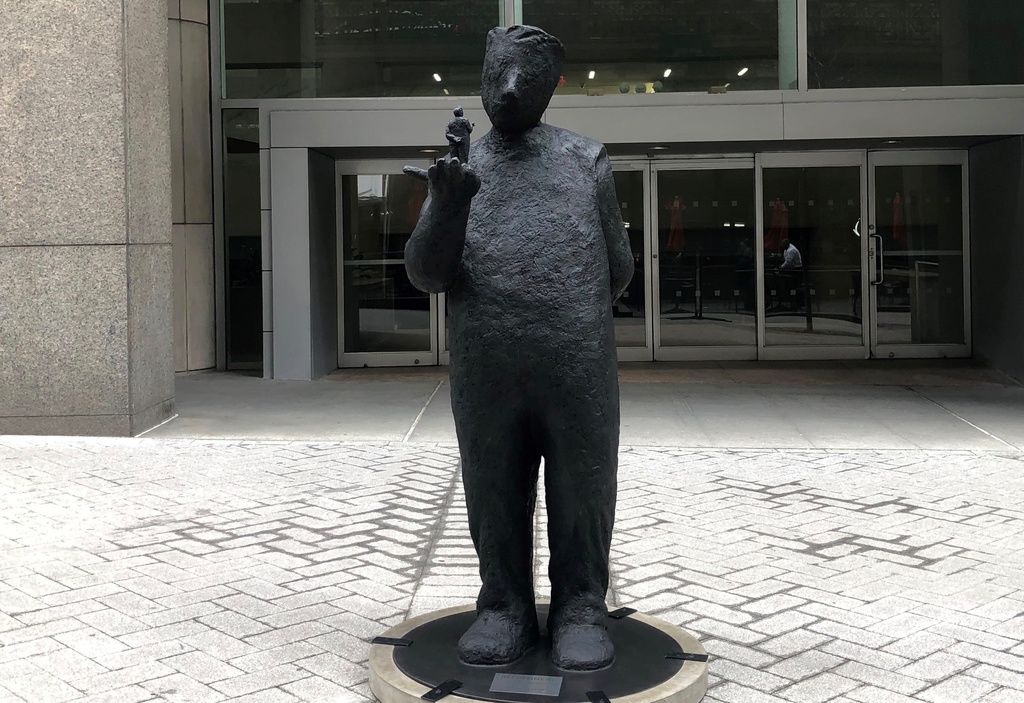
Timing, Inner Dialogue, and Listen are three life-size works by artist Jim Rennert that will be installed in Pershing Square Plaza West across from Grand Central Terminal. Each sculpture stands at over six feet tall and depicts the daily struggles and achievements of everyday people. The sculptural installations are facilitated as part of the New York City Department of Transportation’s Temporary Art Program.
Rennert’s works represent the meeting point between the business world and the everyday lives of ordinary people, similar to how Pershing Square represents the fusion of business and community of the neighborhood surrounding Grand Central Terminal. The sculptures are available through December 2021.

In recognition of Earth Month, the Port Authority bus terminal is hosting a new exhibit that focuses on the collection and clean-up of marine debris from New York City beaches. The Wash features 29 photographs framed in a portal motif that resembles a line of washing machines.
The new outdoor mural is the creative inspiration of Brooklyn-based artist Basia Goszczynska, in partnership with the Port Authority and local artist collective ChaShaMa. The public art piece highlights the need to keep marine life clean and healthy.
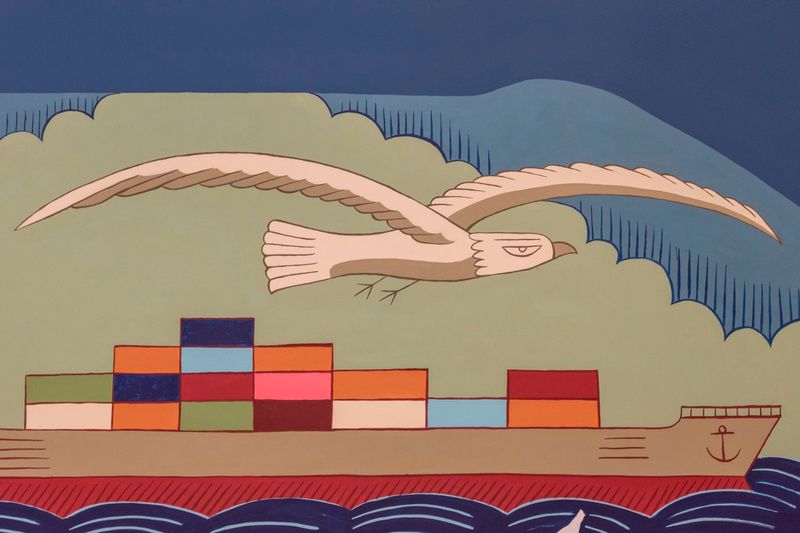
In his large mural work for the Governors Island Ferry Building, artist Duke Riley expands on the ships in a bottle tradition of preciously crafted objects by using a more common bottle of today—single-use plastic containers found floating in oceans worldwide. However, unlike their blown glass and wood-ship-in-a-bottle counterparts, Riley’s painted vignettes appear etched like scrimshaw on the surfaces of items that plague our waterway ecosystems, such as detergent bottles and caulking tubes.
“As a historic center for the arts, Governors Island is proud to welcome yet another celebrated artist to enliven our public spaces,” said Clare Newman, President and CEO of the Trust for Governors Island. “Riley’s work marries the Harbor’s rich history with the Island’s present focus on the pressing issues of the ongoing climate crisis. This intricately beautiful mural looks to both the past and the future, giving visitors the chance to pause and reflect as they enjoy everything the Island has to offer.” The mural will remain on exhibit for the long term.
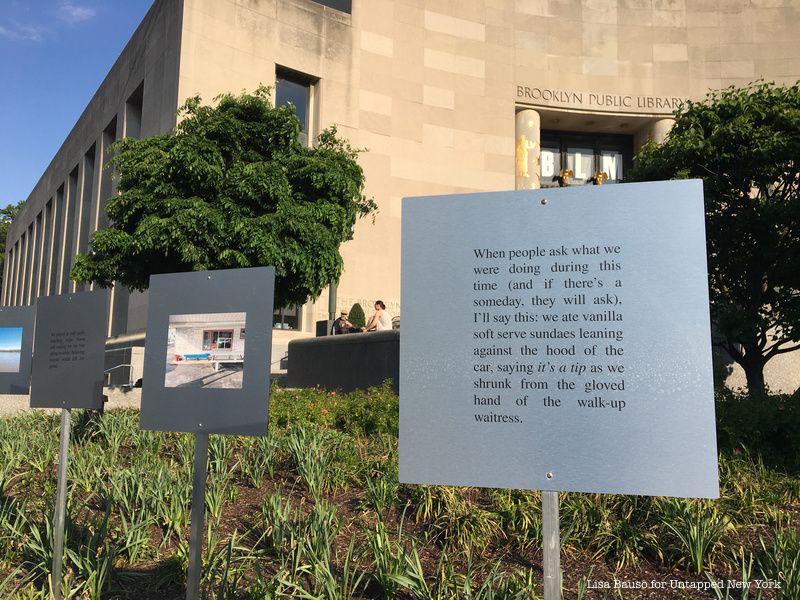
The Parts is a piece by Brooklyn-based conceptual artist Chloë Bass, Brooklyn Library’s Katowitz Radin Artist in Residence for 2021. The piece is a multiform physical installation, realized as text and images, installed in the exterior landscape of Central Library at Grand Army Plaza.
The installation includes two double-sided flags activating the exterior of BPL’s recently inaugurated Center for Brooklyn History. The flags contain images of the artist’s daily life and reflective personal texts, “which reside at the intersection of aphorism, diary entry, and prose poetry.” The project started on Instagram and will now be on display at several library branches. It will be on view through September 20, 2021.
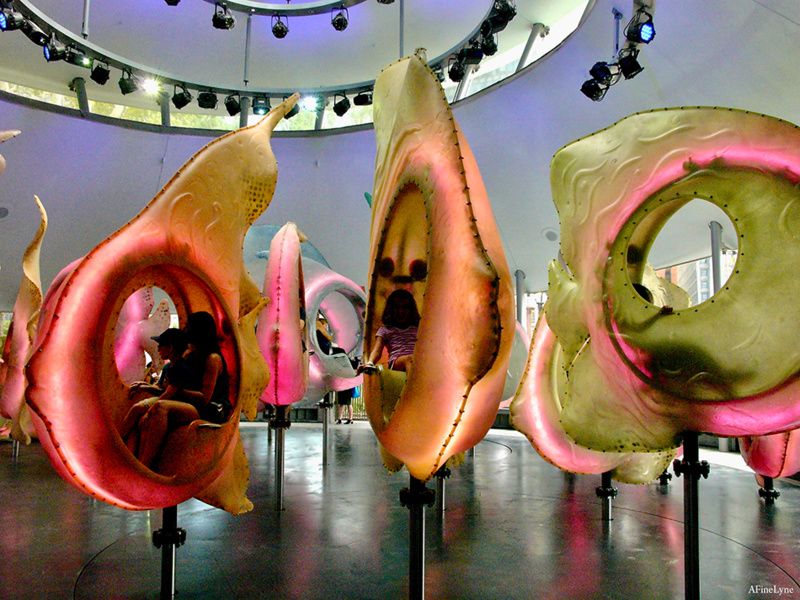
The SeaGlass story began in the early 2000s when The Battery Conservancy was designing the park’s interior. The southern end of the park needed more light, so the design team came up with the idea of an aquatic carousel to conjure The Battery’s history as the first home of the New York Aquarium. Inspired by the chambered nautilus, the spiraling pavilion of glass and steel brings art, architecture, and music to children of all ages.
The George Tsypin Opera Factory created a mystical underwater experience that you can take part in this month at the carousel. The rider sits within iridescent fish that glide through the sights and sounds of a 360° aquatic adventure. Tickets are $5.00. Be sure to check times and dates on the carousel’s website. The carousel is open through September.
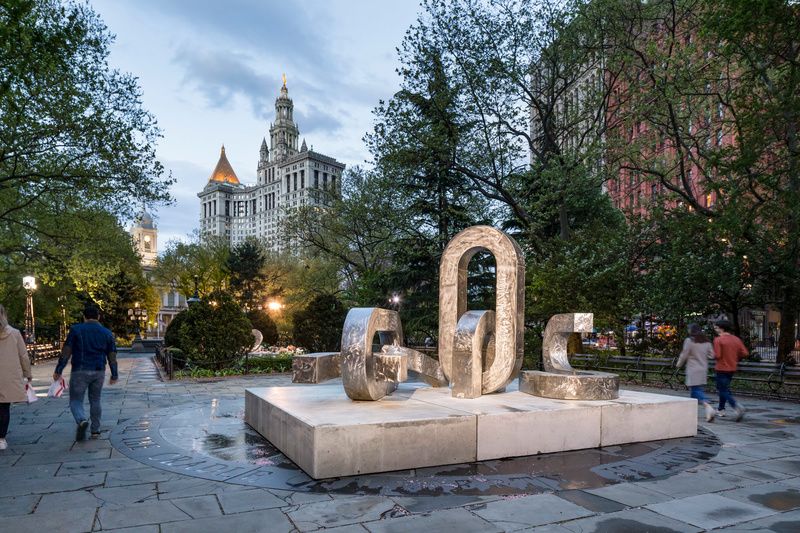
The Public Art Fund has announced a survey of Melvin Edwards’ work. a collection of six sculptures titled Brighter Days. The displayed work will feature both newly commissioned pieces and five sculptures made between 1970 and 1994. Edwards was the first African American sculptor to have a solo exhibition at The Whitney, doing so in 1970.
Edwards often uses chains in his work, a symbol of bondage and oppression as well as connection. The location of City Hall Park, located on a 1700’s African American Burial Ground, is a fitting and powerful one. The Brighter Days exhibition on display through November 28 is free and open to the public.
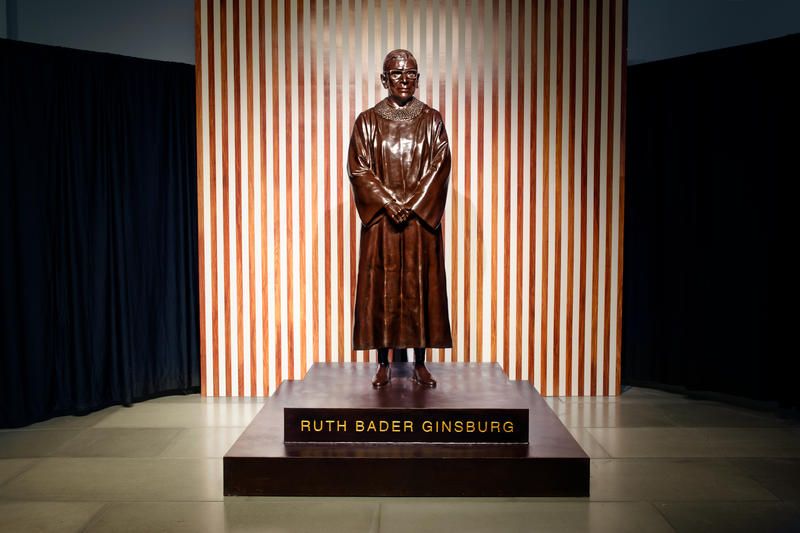
Artist duo Gillie and Marc created this bronze of late U.S. Justice Ruth Bader Ginsburg to commemorate her fight for gender equality and human rights. The statue is one of ten statues of notable women installed in New York City to increase the representation of women in public sculpture from three to ten percent. The statue is on view from noon to 8 p.m. daily in the lobby of City Point in Downtown Brooklyn.
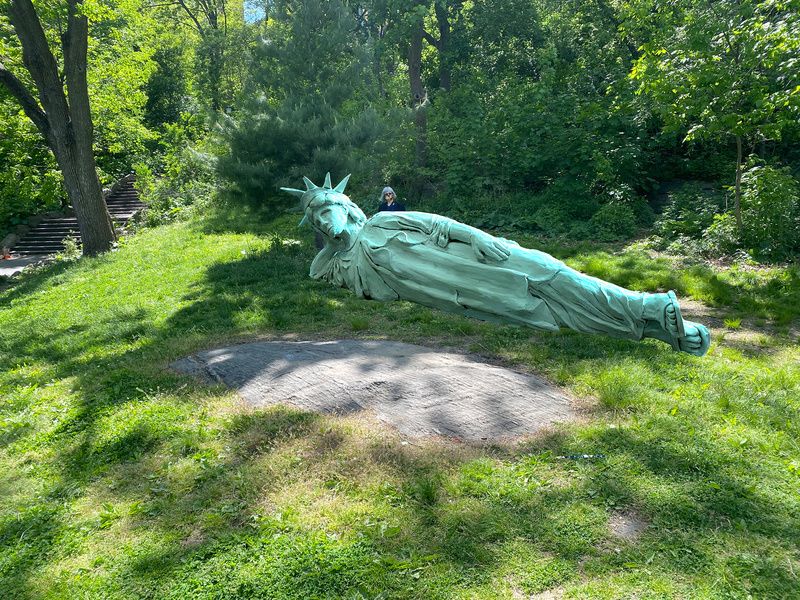
Reclining Liberty by artist Zaq Landsberg is set to premiere, after much delay, in Morningside Park on April 26. The slightly weary-looking Lady Liberty seems to be waiting, like most of us, for better days that surely are coming. The artist, in explaining his draw to monuments, states, “They are literally where the political and the aesthetic meet.”
You can visit the statue at the base of the stairs at 120th Street and Manhattan Avenue in Harlem. Reclining Liberty will remain on view through April 25, 2022.
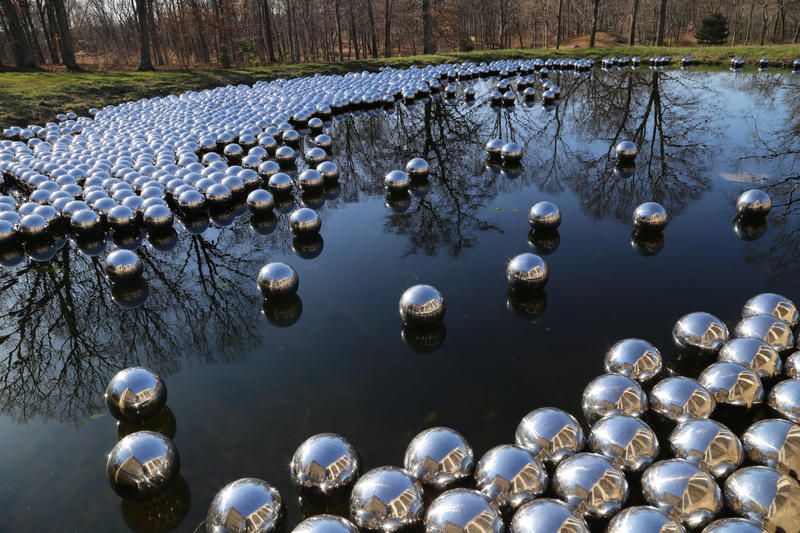
The long-delayed garden exhibition KUSAMA: Cosmic Nature is now open at the New York Botanical Garden. The exhibition will be a comprehensive survey of the Japanese artist Yayoi Kusama and her lifelong obsession with the natural world. KUSAMA: Cosmic Nature will include programs, a publication, and exhibits both in the gardens and within the surrounding buildings of the 250-acre landscape.
The artist’s spectacular sculptures, signature polka-dotted organic forms, and mesmerizing paintings of plants and flowers will be presented along with archival material never before publicly exhibited. The change of seasons will complement the spectacular works during the exhibit’s six-month run. The exhibit is on view from April 10 through October 31, 2021. Tickets are available through the New York Botanical Garden’s website.
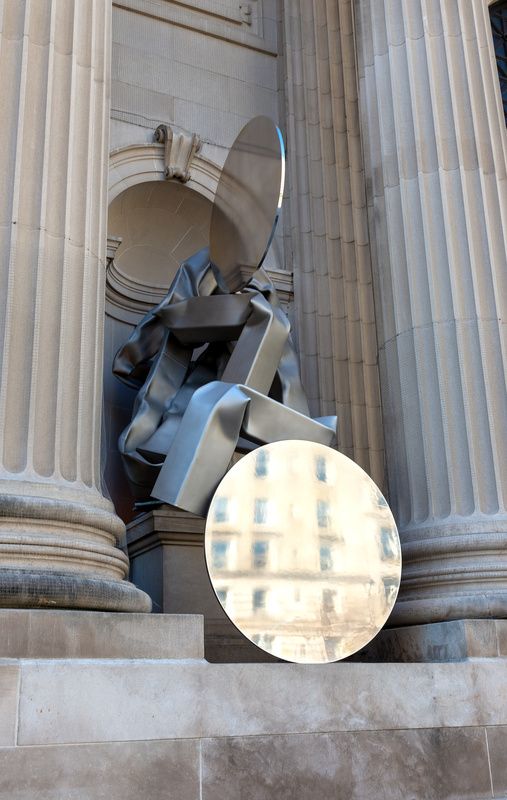
The séances aren’t helping by Carol Bove will be the second commission featured on the facade of The Met Fifth Avenue. The spaces Bove’s work will fill have historically been empty. Though the niches were intended to contain art, they were empty for 117 years. Bove’s four massive works are sculpted into nonrepresentational forms that “resonate with modernist styles such as Art Deco and abstraction.”
Bove’s piece contrasts the classical style of Richard Morris Hunt‘s facade design, which “subtly calls for us to reevaluate and reckon with the legacies of tradition.” The tile also, The séances aren’t helping, further emphasizes the ongoing struggle to reckon with our past. The sculptures will be on display until November 2021.
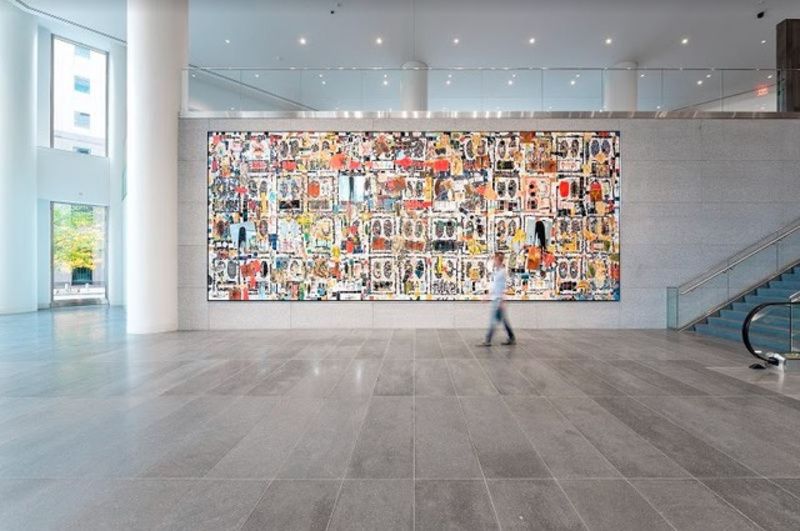
The works of Rashid Johnson employ a wide range of mediums to explore the themes of art history, individual and shared cultural identity, personal narratives, and materiality. His work often includes diverse materials rich with symbolism and personal history.
The mosaic Untitled Broken Crowd is composed of handmade ceramics, wood, brass, oyster shells, spray paint, wax, soap, and mirrors. The soaring piece spans 14 by 33 feet. Located at 200 Liberty Street at Brookfield Place, visitors will be able to contemplate Johnson’s extraordinary piece mounted in the lobby entrance. The glass facade of the building also allows the piece to be highly visible from the surrounding streets.
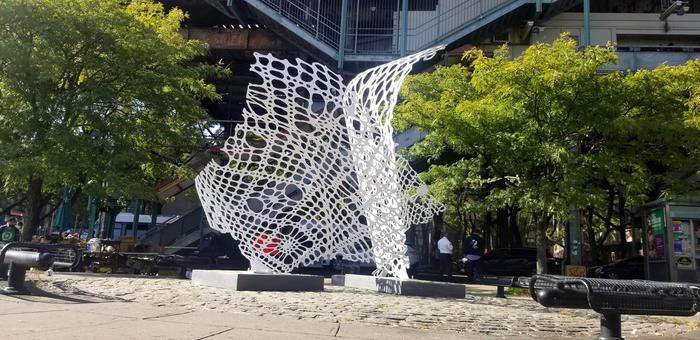
At West Farms Square Plaza in the Bronx, artist Samantha Holmes has crafted a giant steel sculpture that looks dainty but is strong and resilient. The painted steel sculpture, tilted Mundillo (Little World), is a “monument to women’s work and the cultural dynamism of the Bronx.” Holmes takes inspiration from the patterns of traditional Puerto Rican lacework to represent softness, while the steel reveals strength.
Openings in the sculpture’s lace-like surface allow it to seemingly weave into the fabric of the surrounding neighborhood, as those holes are filled with the colors and sights of the neighborhood. Holmes’ sculpture was commissioned by the Bronx River Arts Center and the NYC Department of Transportation as part of its Arts Community Commissions series. The piece will be on view adjacent to the East Tremont Avenue subway station through September 2021.
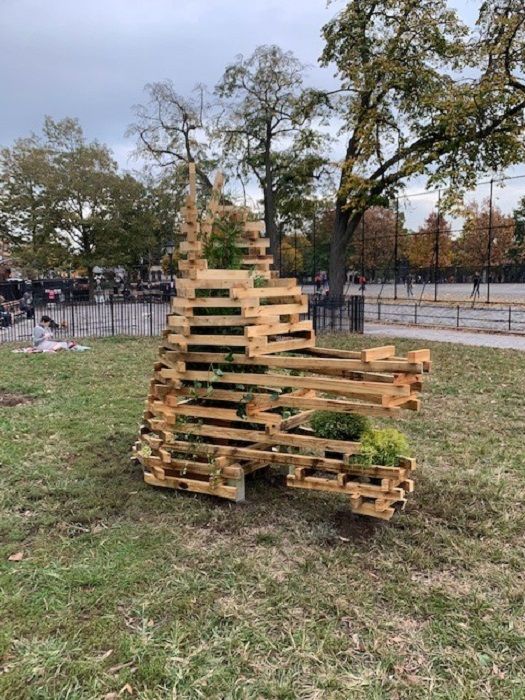
Artist Alex “Rocko” Rupert’s wooden wolf head structure TimberWolf at Maria Hernandez Park in Brooklyn takes utilitarian materials like reclaimed lumber to serve as a metaphor for how everyday materials can be repurposed. The structure plays into the importance of resourcefulness, breathing use back into what is considered “used-up.” The artwork takes the form of a dog’s head, a nod to the popular nearby dog park.
At the end of the public art installation period next October, TimberWolf will be donated to another public space to be enjoyed. The possibility to be reused or repurposed with additional functionalities gives this living installation another life. The installation will be on-site through October 25, 2021.
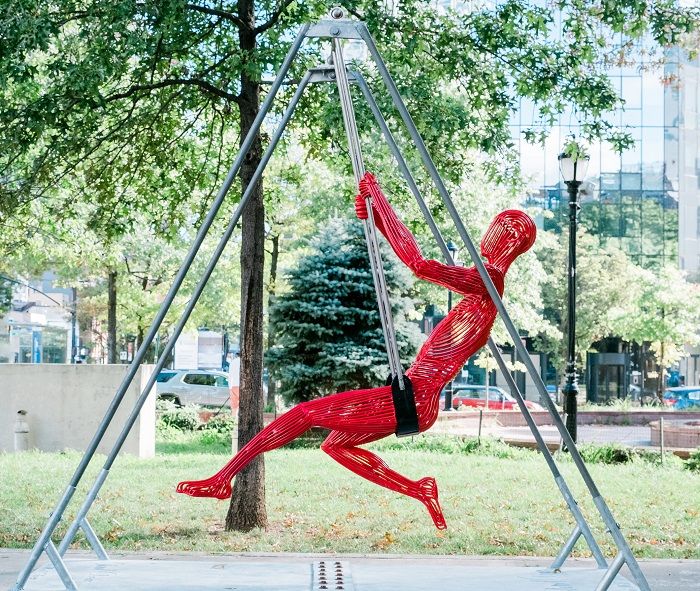
Long Island City-based sculptor Jack Howard-Potter makes large, often kinetic, figurative steel sculptures that can be seen at city government buildings, sculpture parks, and public art shows around the country. The outdoor public arena is the perfect setting for the academic roots to be easily recognizable and accessible bridging the gap between the fine art institution and the public. It all comes together in an effort to brighten the landscape and shift one’s gaze to break the daily routine with something beautiful.
Torso II, Swinging II, Messenger of the Gods will be on-site at Court Square Park in Queens through September 12, 2021.
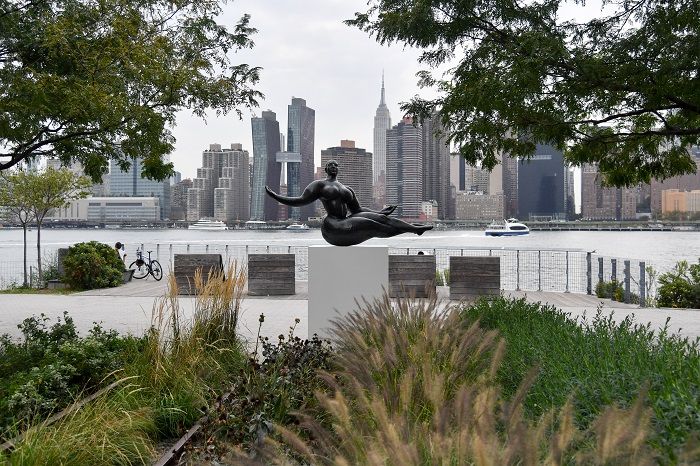
Located in Hunter’s Point South through September 2021, Floating Woman is one of French sculptor Gaston Lachaise’s best-known works dating from the late 1920s. The buoyant, expansive figure represents a timeless earth goddess, one Lachaise knew and sought to capture throughout his career. This vision was inspired by his wife Isabel, who was his muse and model, the “majestic woman” who walked by him once by the bank of the Seine. This work is a tribute to the power of all women, dedicated to “Woman,” as the artist referred to his wife.
Lachaise devoted himself to the human form, producing a succession of powerfully conceived nude figures in stone and bronze that reinvigorated the sculptural traditions of Auguste Rodin and Aristide Maillol.
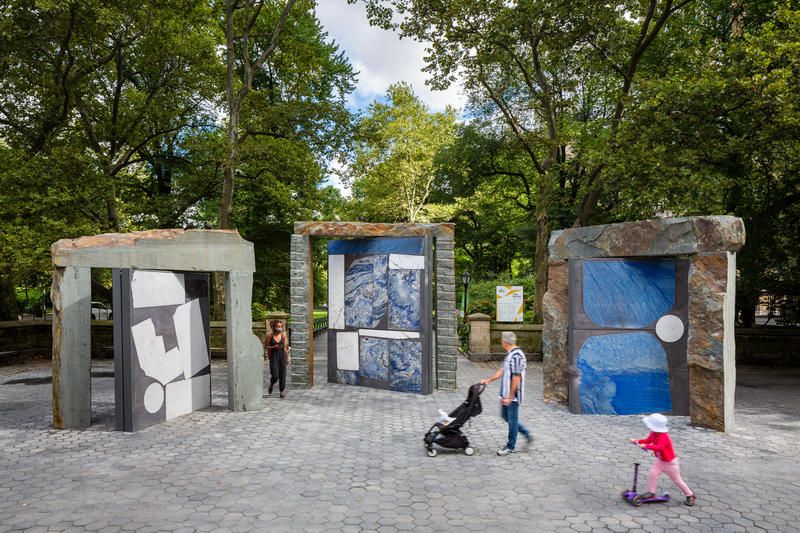
Artist Sam Moyer created a massive three-part hybrid sculpture called Doors for Doris using imported stones and rock indigenous to New York to pay homage to Public Art Fund founder Doris C. Freedman. The sculpture stands at the plaza named for her outside Central Park.
According to Public Art Fund’s website, “these polished stones bear the markings and shapes of their original uses. They also display the unique colors, patterns, and geological history of their sources — quarries in Brazil, China, India, Italy, and beyond. Each stone in Moyer’s mosaic compositions takes on an even more striking hue against the others and the locally-quarried rock, an apt metaphor that encourages us to consider the diverse character of our city and our interconnected lives within it.” The installation is running from September 16, 2020, to September 12, 2021.
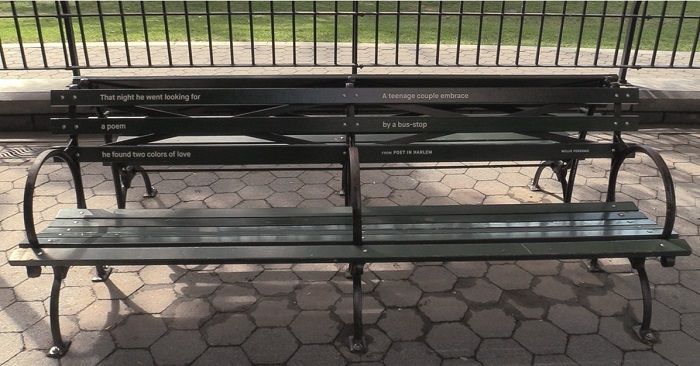
Poets House and Battery Park City Authority (BPCA) launched the Poetry Path, an immersive public art installation featuring work from more than 40 poets. Poetry Path occupies the northern length of Battery Park City, from Nelson A. Rockefeller and Teardrop Parks to the North Cove Marina.
The works of the poets, with themes of the relationships between people, nature, and the urban landscape, are reproduced on bench slats, banners, pavers, pathways, and signs. The installation will be up through 2021.
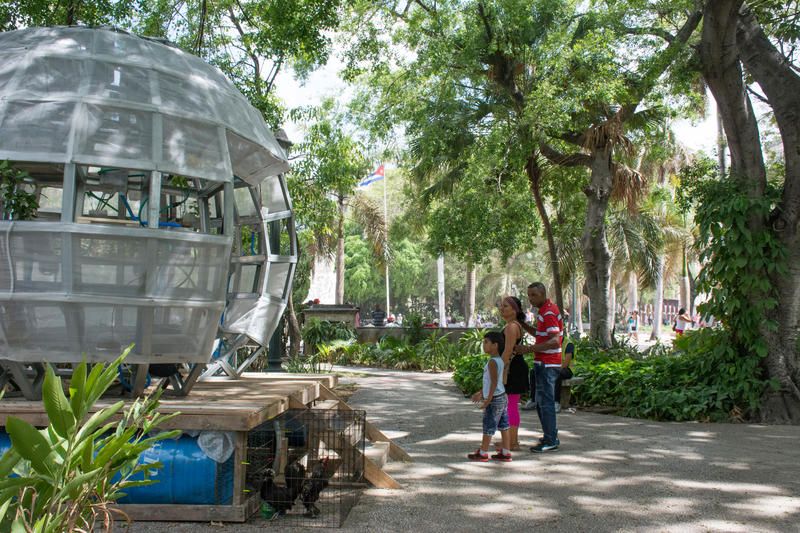
PUBLIC WATER is an eco-conscious, active ten-foot geodesic dome installation in Prospect Park that invites the public to consider this precious resource. According to artist Mary Mattingly, “The sculpture draws from the minerals and geologic features of the watershed to filter water. PUBLIC WATER brings attention to New York City’s drinking water system in order to build more reciprocal exchanges between people who live in New York City’s drinking watershed and its drinking-water users in the city, to promote care and commons.”
The project includes a water-filtering sculptural ecosystem and a self-guided walking tour through the park’s watershed, designed in connection with the launch of ecoWEIR, a natural filtration pilot project for the park’s manmade watercourse. It is on view through September 7, 2021.
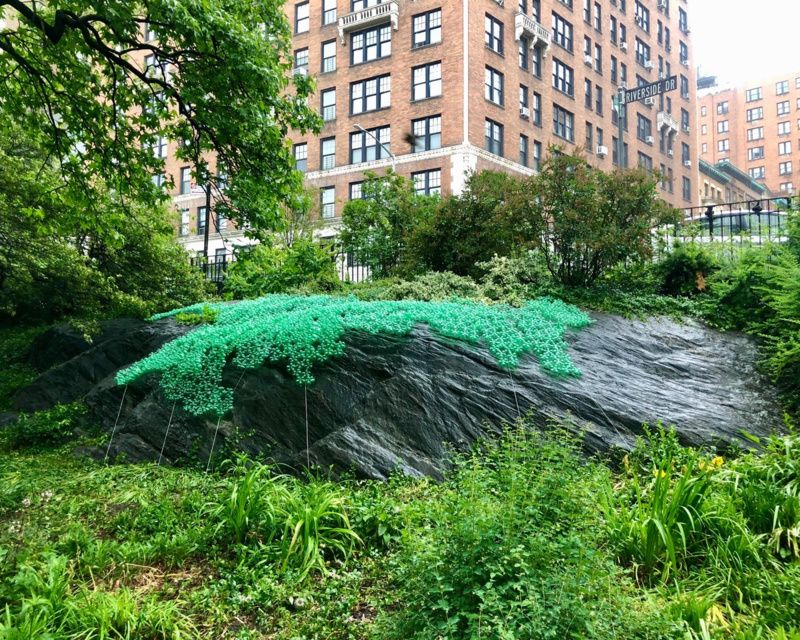
Through September 13, 2021, Karin Bravin‘s public art exhibition, Re: Growth, A Celebration of Art, Riverside Park and the New York Spirit, will be on display in Riverside Park, spanning from 64th Street to 151st Street. It was created in celebration of Riverside Park Conservancy‘s 35th Anniversary and as a testament to the City and Park’s resilience this past year. The exhibition includes 16 site-specific installations and ten flag and banner projects — centered around the theme of regrowth in the literal, metaphorical, poetic, and philosophical sense. Some of the featured artists in the exhibition include Jean Shin, Vanessa Albury, Weenie Huang, Mary Mattingly, David Shaw Jean Shin, Woolpunk, and many others, some of whom’s work will be discussed later.
“Public art engages visitors when they least expect it,” Bravin said of the exhibition. “I am inspired by this element of surprise, where art meets viewers in their own world. Projects like this, that remove gallery walls, make both art and nature accessible to all.”
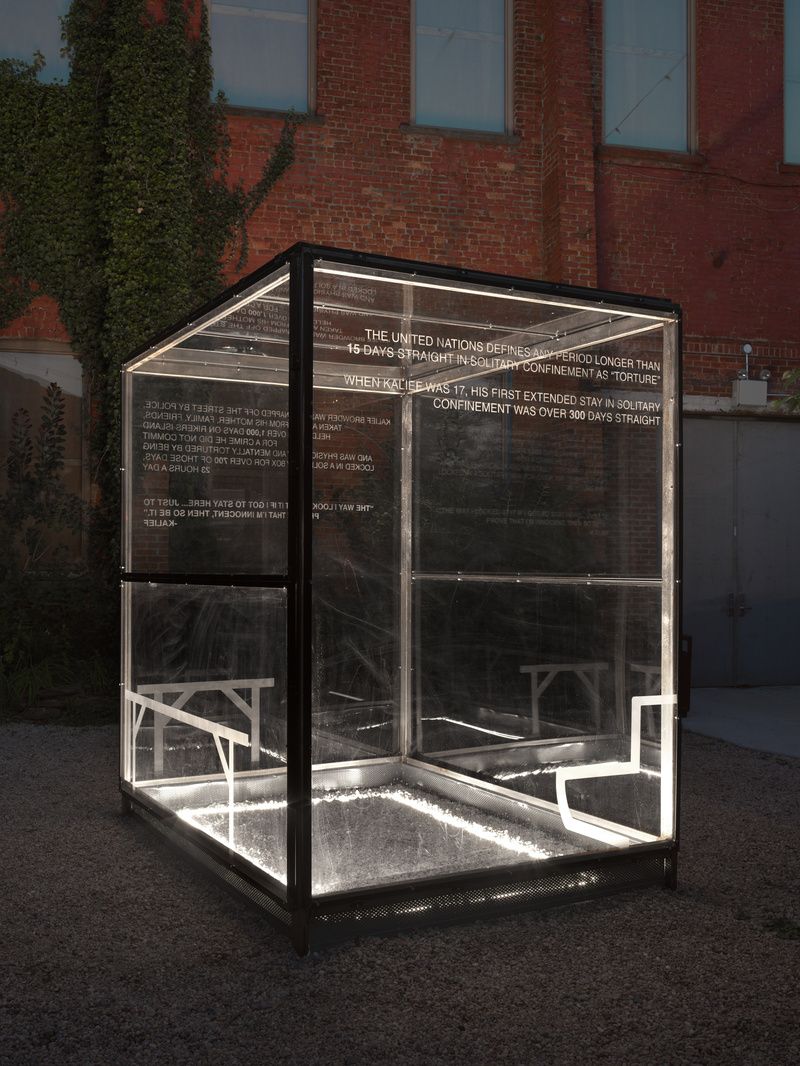
On display until September 19 at Pioneer Works, artist Coby Kennedy’s new installation Kalief Browder: The Box draws inspiration from the tragic story of Kalief Browder. Imprisoned in 2010 at the age of 17 for a robbery he did not commit, Browder spent three years at the violent Robert N. Davoren Center on Rikers Island. Here, he was subject to physical and mental abuse from prison guards and inmates and over 700 days of solitary confinement. Although released from prison in 2013, the long-lasting trauma from Browder’s experiences and his ensuing depression would lead him to commit suicide in 2015. To convey this injustice, Kennedy created an 8-by-10-by-6-feet glass box sculpture that replicates the exact dimensions of a solitary confinement cell.
The sculpture’s glass surfaces feature line renderings of the bed, barred window, and toilet found in confinement cells. Additionally, the walls include texts about Guantánamo Bay and the country’s carceral system — critiquing the gross abuses of civil liberties suffered by individuals whose crimes are unfairly or never tried. Lit from below, Kalief Browder: The Box shines throughout the night, serving as a testament to the endurance of Browder’s family — whose civil lawsuit against the city was settled in 2019, though no one was held accountable in the end. In addition, Kalief Browder: The Box will be paired with a four-part Town Hall series co-presented with For Freedoms and Negative Space. The remaining third town hall meeting, HEALING through Community Collaboration, will take place on August 22, with the fourth and final meeting, JUSTICE for Our Future, taking place on September 19, both at Pioneer Works. Ultimately, for Kennedy, “It is [his] hope that, when viewers happen upon this sculpture, they can emphatically feel the weight of being put into a box and having it become your life for a long, unknowable future.”
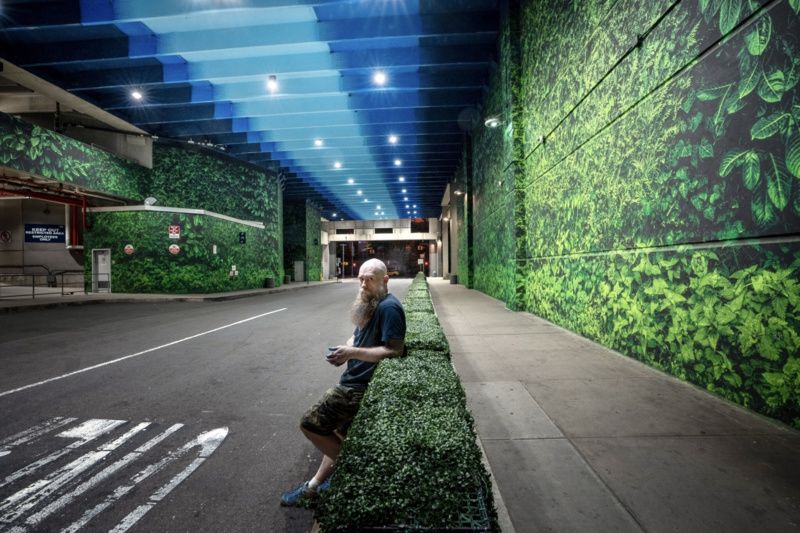
In July 2021, American contemporary artist Logan Hicks completed Tunnel Vision, the world’s largest stenciled mural. Presented by Taglialatella Galleries, the mural is 19,000 square feet — created with over 100 gallons of paint, 500 cans of spray paint, hundreds of stencils, and dozens of rolls of Gorilla Glue. Located within the East River Plaza on 117th Street in East Harlem, Tunnel Vision includes vivid imagery of lush greenery climbing up the 30-foot walls before merging into the sparkling blue-painted ceiling.
Inspired by Christian Cooper — a Central Park birdwatcher who was victimized in a racially charged confrontation with Amy Cooper in May 2020 — Hicks aimed for Tunnel Vision to recreate the feeling of visiting the Ramble. To accomplish this, dozens of stenciled birds that live within New York State were drawn into the green thicket on the wall. In relation, the mural is accompanied by a custom-designed sound installation featuring a four-hour looping soundtrack, featuring the calls of every bird indigenous to New York. Reflecting on Tunnel Vision, Hicks stated: “This started with a vision of going beyond making just a mural. I wanted to make an environment where people could forget they were in the middle of the city — even if only for a moment.”
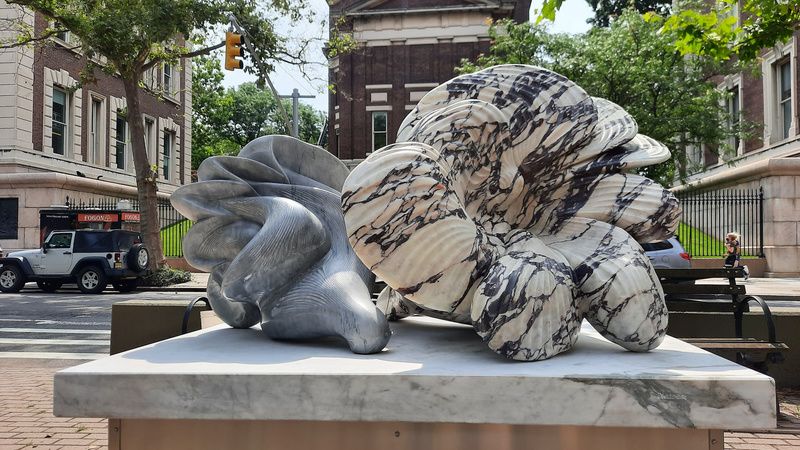
For nine months from August 2 to Spring 2022, the Broadway Mall Association will present Jon Isherwood’s Broadway Blooms: Jon Isherwood on Broadway — a series of eight marble sculptures located on the green malls at the center of Broadway from 64th Street to 157th Street. Originally planned for display in 2020, the exhibition’s sculptures were delayed in being transported from Isherwood’s studio in Italy due to the COVID-19 pandemic. Broadway Blooms will mark the Broadway Mall Association’s 13th sculpture show since 2005 as part of their Art on the Malls program.
Each sculpture’s design in Broadway Blooms was inspired by flowers and their diverse cultural meanings — ranging from the imbued spiritual symbolism of the lotus flower to the holiday tradition of poinsettias. Moreover, flowers reflect one’s connection to themselves and their surrounding community; this is reflected in the sculptures’ placements at a series of major intersections along Broadway — which promotes a sense of interconnectedness in spaces that are otherwise impersonal. Carved in Bardiglio Imperiale, Fantastico Arni, and Rosa Portogallo marble, Broadway Blooms offers a beautiful respite from the surrounding urban landscape. At the same time, Broadway Blooms distorts the flowers’ natural appearance, with carved lines contouring the sculptures’ surfaces to create an illusion of expansiveness and promote associations of patterning, layering, and veiled imagery.
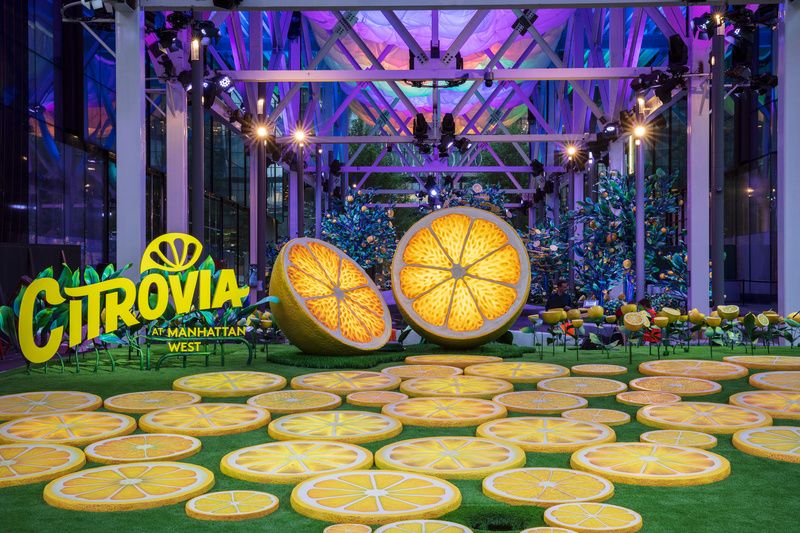
As a creative addition underneath the canopy of the required construction shed of Two Manhattan West — Brookfield Properties‘ new 58 story tower set to open in 2023 in Hudson Yards — the company has commissioned Citrovia. Covering over 30,000 square feet of the pedestrian walkway from Moynihan Station to 10th Avenue, Citrovia is a stunning garden consisting of a series of 10-to-20-feet-high lemon trees made from steel and plaster. Attached to the trees are 700 oversized lemons and 3,800 handcrafted leaves made of steel and foam, painted in shades of green and purple. Citrovia is free and open to the public 24 hours a day, 7 days a week. The space is friendly for people of all ages and will even offer interactive augmented reality games for children. Passersby will also have the opportunity to potentially sample citrus-inspired scents. The installation was designed by Cuttlefish, an award-winning team of creative technologists producing experimental work for big-name companies such as Chanel and Apple. Each element of the installation was fabricated by Adirondack Studios, which built Star Wars Galaxy’s Edge at Universal and Diagon Alley at the Wizarding World of Harry Potter.
As Sara Fray, SVP of Marketing for Brookfield Properties stated in a press release, “Citrovia exists for New Yorkers’ pleasure alone. It has no other purpose. We wanted to create a space that’s welcoming and bright to make better use of a space that would otherwise be ugly or inaccessible. It’s not solving the world’s problems, but it’s a delightful midday encounter.”
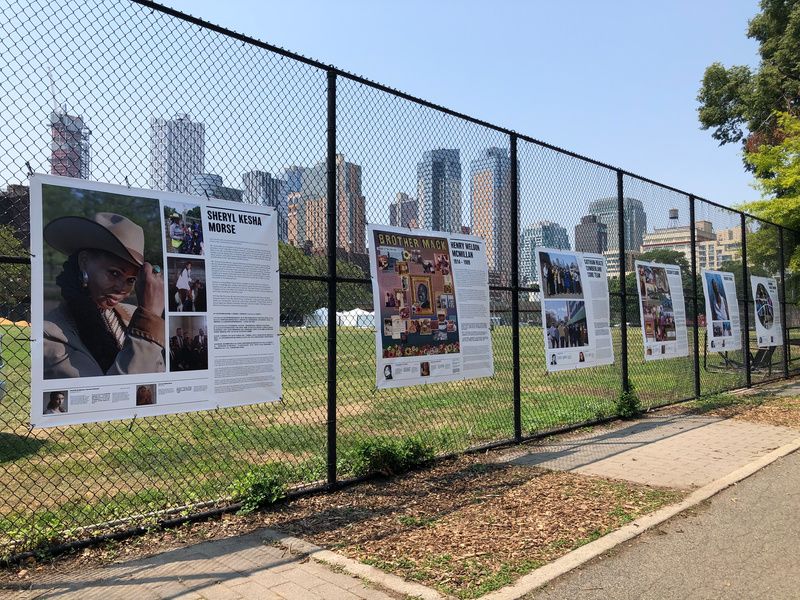
Community Heroes is a community-based public art project celebrating people whose generosity is felt throughout their community. Co-founded in 2016 by Jasmin Chang and Zac Martin in their neighborhoods of Fort Greene and Gowanus, the project aims to highlight the achievements of everyday citizens. Special attention is paid to selecting persons of color from often overlooked communities who have had a faithful and stable long-term presence in their neighborhoods through volunteering, advocacy, mentorship and creativity. Organized and produced by Photoville and Trellis, Community Heroes receives additional support from Partnerships for Parks and PhotoWings. Past projects have included Arts to End Violence, a showcase of young artists committed to anti-violence work, and It’s Happening, a celebration of 50 years of the Arts in the Park program.
To produce their work, Community Heroes partners with communities across NYC to nominate heroes. Afterward, these individuals are paired with local artists to make their portraits and youth writers to interview them. The results of this are then displayed as an art exhibition in a local public space. This summer, Community Heroes will have two projects on display. The first is located at Fort Greene Park along the Brooklyn Hospital fence and in Commodore Barry Park along the football field. One featured hero will be Kesha S. Morse, who became the first female member, officer, and President of the New York City Federation of Black Cowboys. This iteration of Community Heroes will run through June 2022. The second project will be open for view from August 10 to July 2022 in Bed-Stuy at St. Andrews Playground along Herkimer Street and Kingston Avenue.
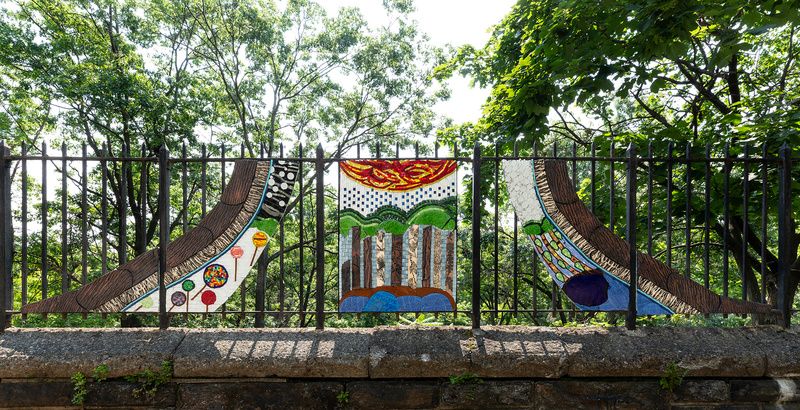
Through June 30, 2022, Susan Stair’s public art exhibition Ascending the Mountain will be on display at Marcus Garvey Park. Drawing inspiration from the underground network used by trees to communicate and share resources, Stair’s exhibit tells a story of remarkable natural growth. What began as a few trees planted during the early 20th century on a mountain of Manhattan Schist has since grown into a sprawling urban forest — its roots pushing down through the land’s rocky outcropping. Today, the naturally seeded forest provides shade, moisture and oxygen while attracting birds and small animals to the surrounding neighborhoods of Harlem.
Ascending the Mountain was installed in three distinct sections along the staircase leading up to the overlook terraces known as the Acropolis and the Harlem Fire Watchtower. The installation provides visitors with eye-level views of the adjacent forest area so that viewers can more effectively make direct connections between the exhibit and its surrounding natural environment. The first section, Roots n Rocks — located near the base of the stairs on the east side of the mountain — focuses on the roots of the now mature trees and how they have moved underground to gather nutrients and resources. One level up is the second section Growing Powerhouse, which illustrates the trees’ ability to bring gallons of water and minerals up the side of the mountain through their trunks. Just below the upper level of the park is the final section, Tree Canopy, which encourages viewers to connect the artwork with the real-life treetops.
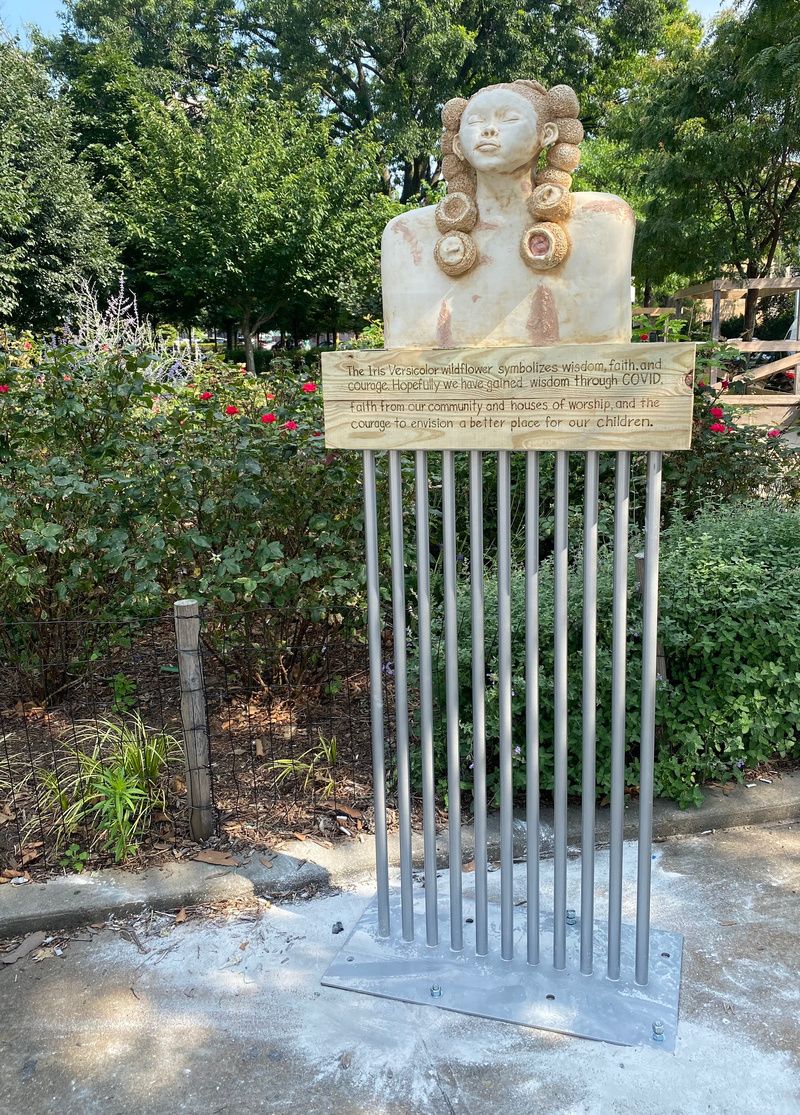
On your visit to Forest Hills this summer, an exciting new artwork to check out is Afro Pick: Remembering & Moving Forward. Surrounded by a beautiful array of Versicolor wildflowers in MacDonald Park, Yvonne Shortt’s larger-than-life afro pick sculpture draws inspiration from the item’s storied history. Originating over 5,500 years ago in Egypt, afro picks were once made from wood or stone and were used to tell narratives of the cultures or tribes carving them. Unrecognizable today from their ancient counterparts, afro picks are now largely fabricated using plastic. Since the 1970s, afro picks have become important symbols of Black power, readily used throughout the ‘Black is Beautiful’ movement. This movement sought to promote an embrace of Black culture and identity, with one crucial element being the adoption of more natural and less Westernized hairstyles. As an ode to this, Afro Pick: Remembering and Moving Forward honors those who have died during the pandemic in Shortt’s community (the artist lost both of her grandmothers). Made from recycled wood, the pick’s handle tells a story of strength and resilience, inscribed with the words: “The Iris versicolor wildflower symbolizes wisdom, faith, and courage. Hopefully, we have gained wisdom through COVID, faith from our community and houses of worship, and the courage to envision a better place for our children.”
Situated at the top of the handle is a bust of a young girl, whose features were drawn from several individuals of different cultural backgrounds living within Shortt’s community. As a symbol of diversity and hope for the future, the girl also serves as a representation of the African American community’s perseverance over time. This is exemplified in her hair texture, which is inspired by African rice braiding, a technique used by enslaved people to prevent hunger during their journeys on the Middle Passage. At the bottom of the statue is a series of metal rods that serve as the teeth of the afro pick, reflecting the move from wooden to metal teeth during the 1950s and 1960s. Six additional afro picks will be installed at Queens College and two at Marymount Manhattan College. In September, three other picks will also be placed at Socrates Sculpture Park as part of Shortt’s Hair Sanctuary sculpture.
Next, check out our upcoming tours to explore more of New York City!
Subscribe to our newsletter